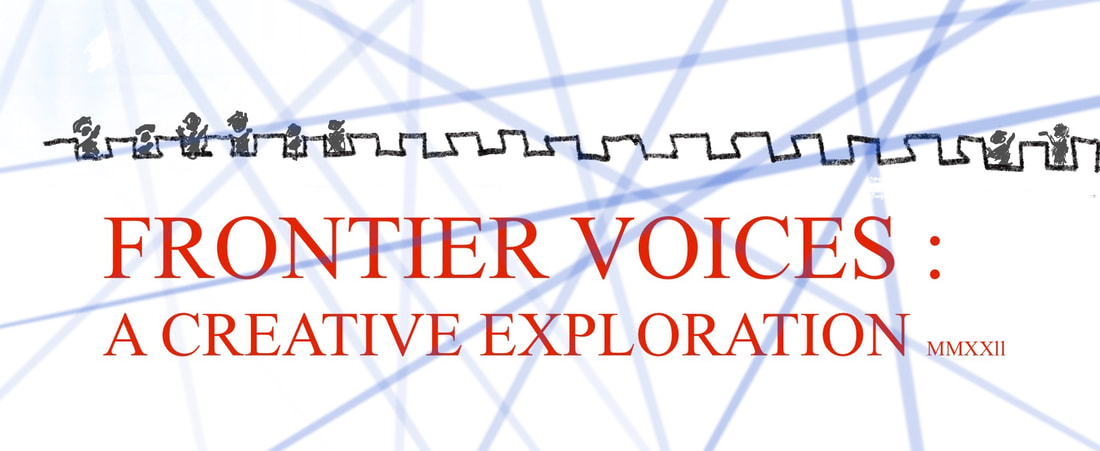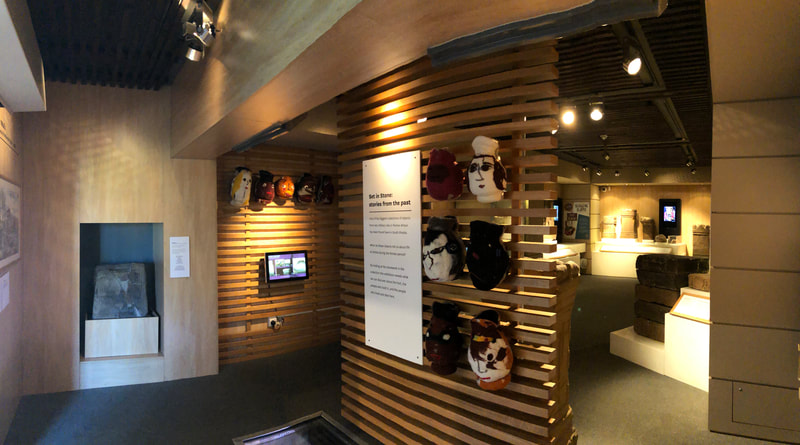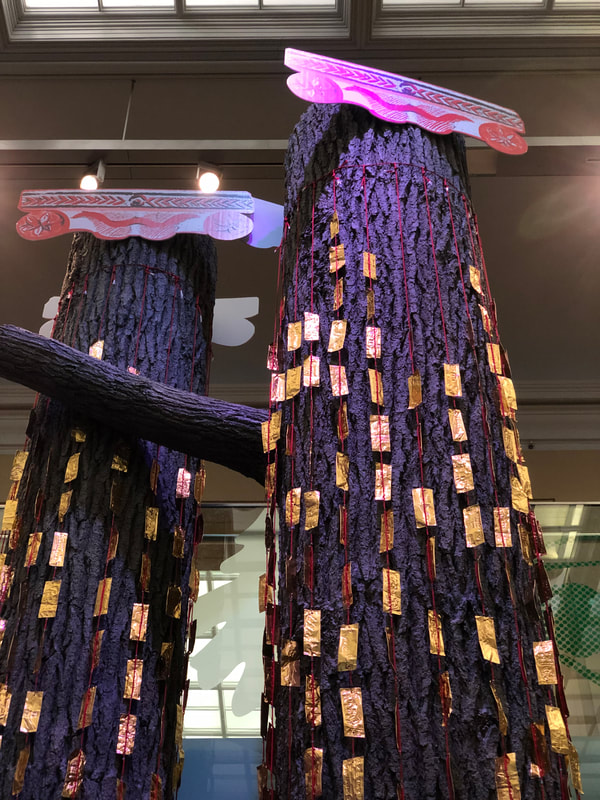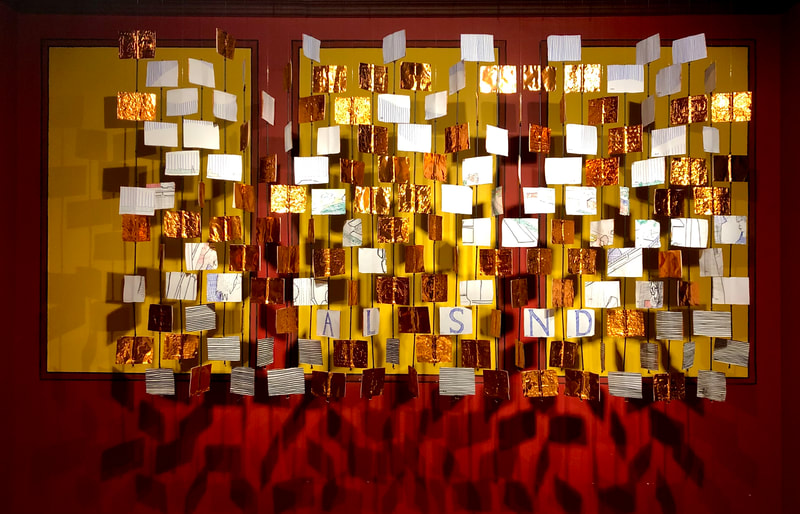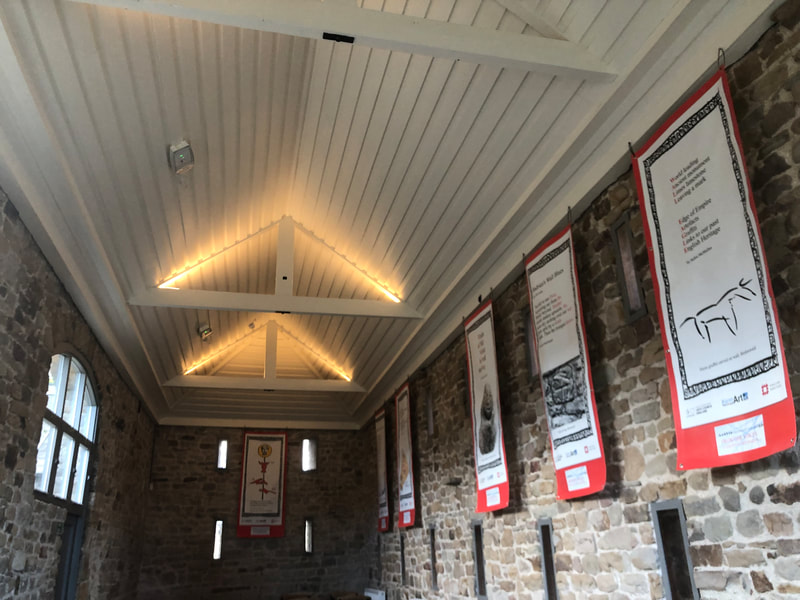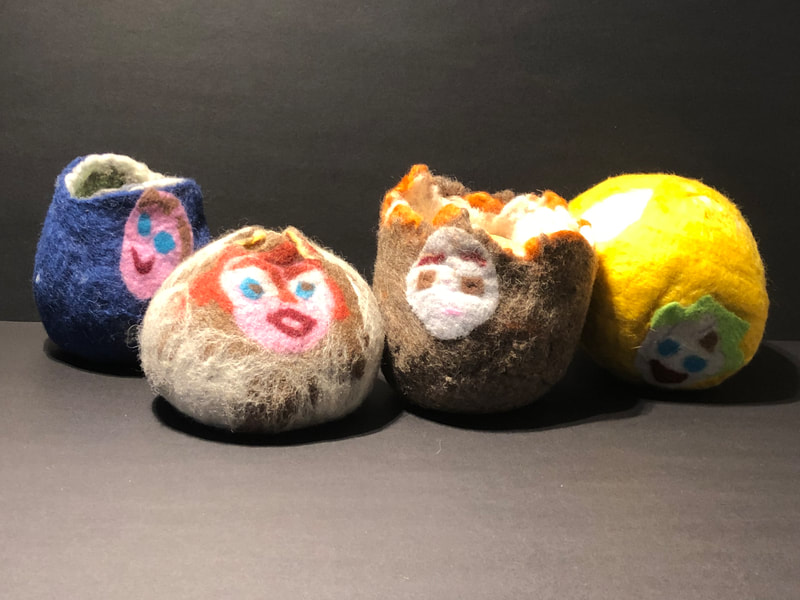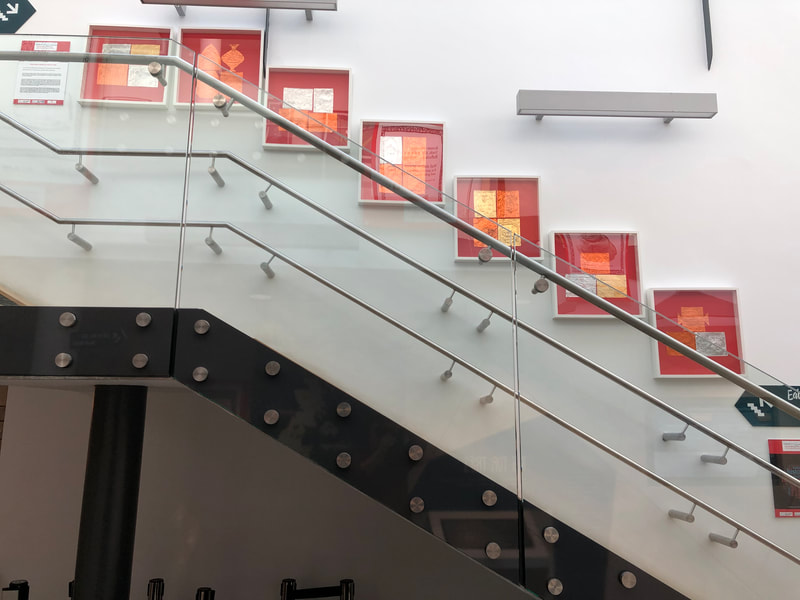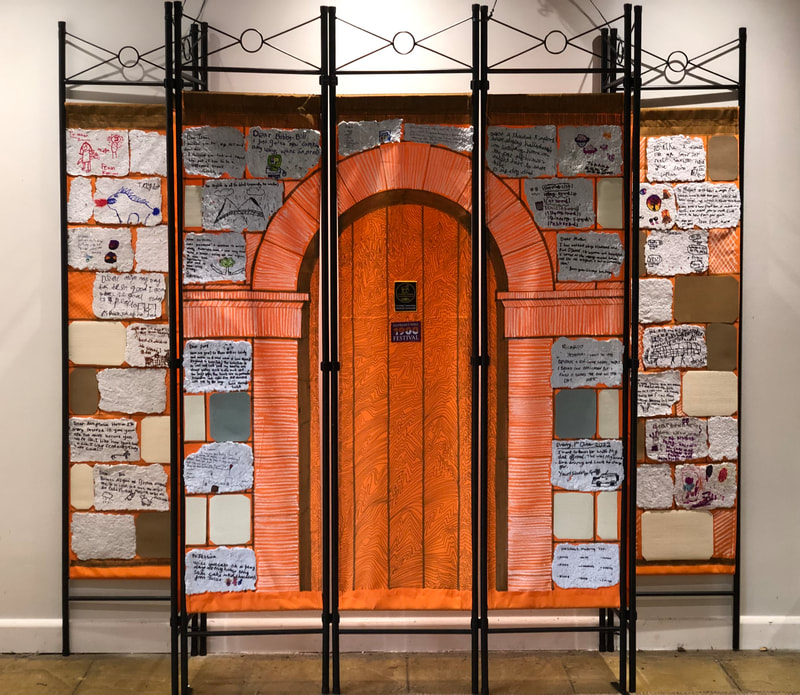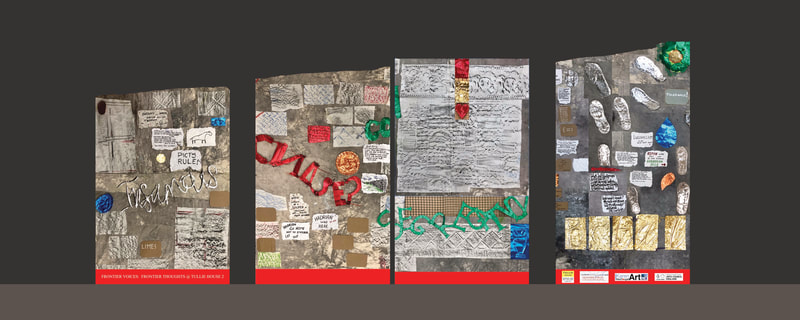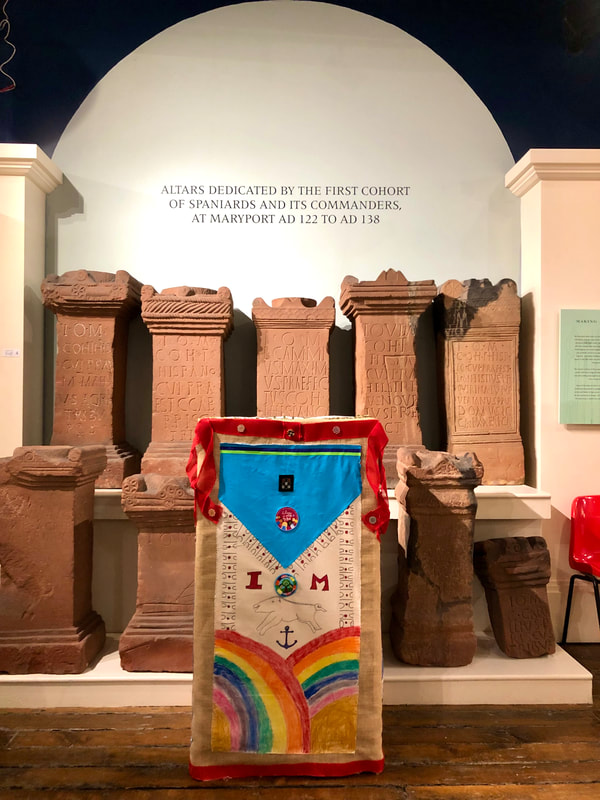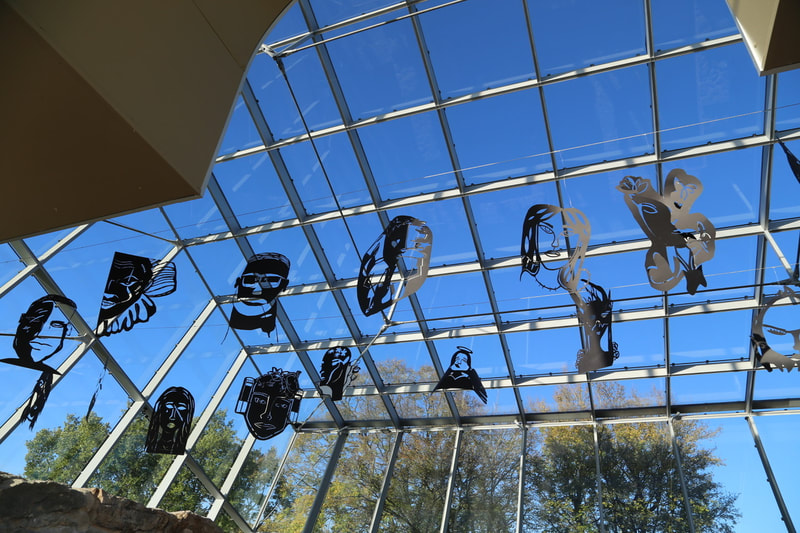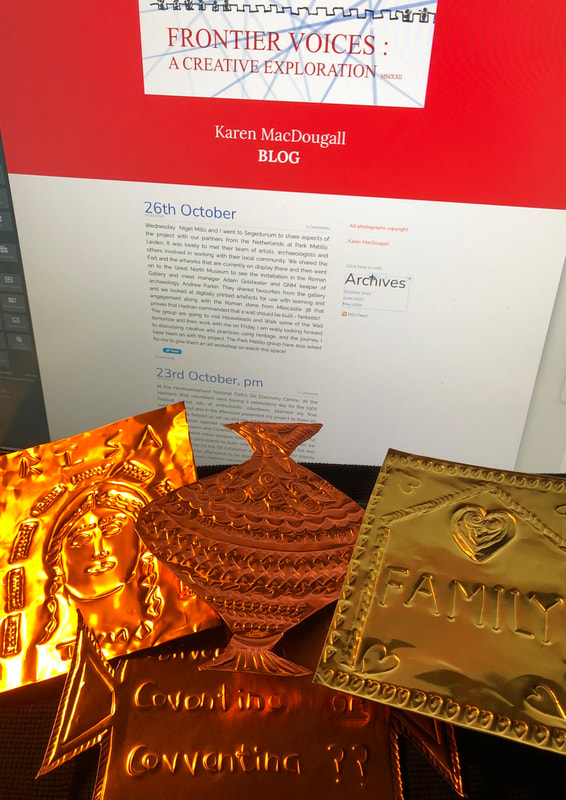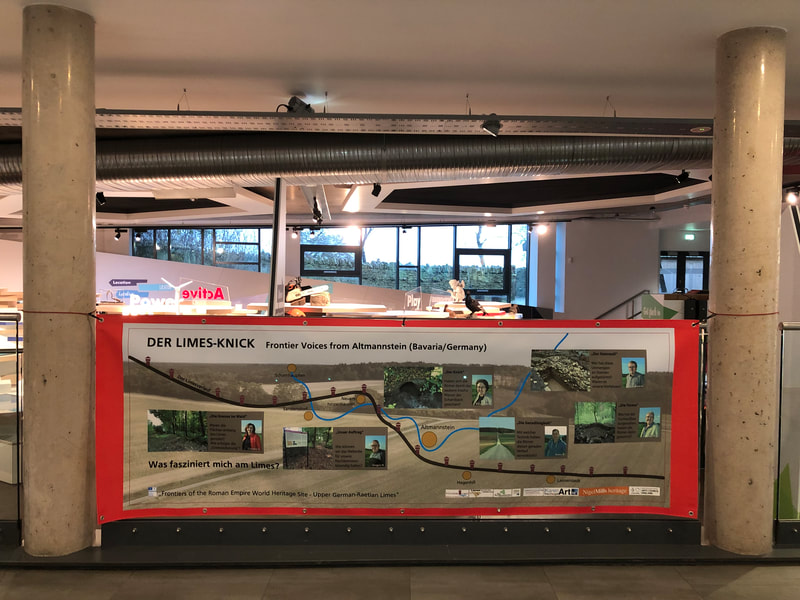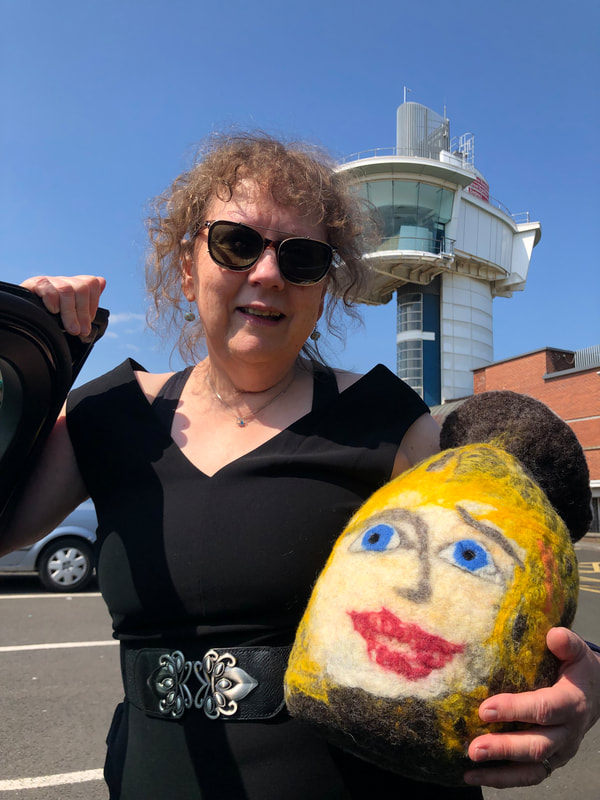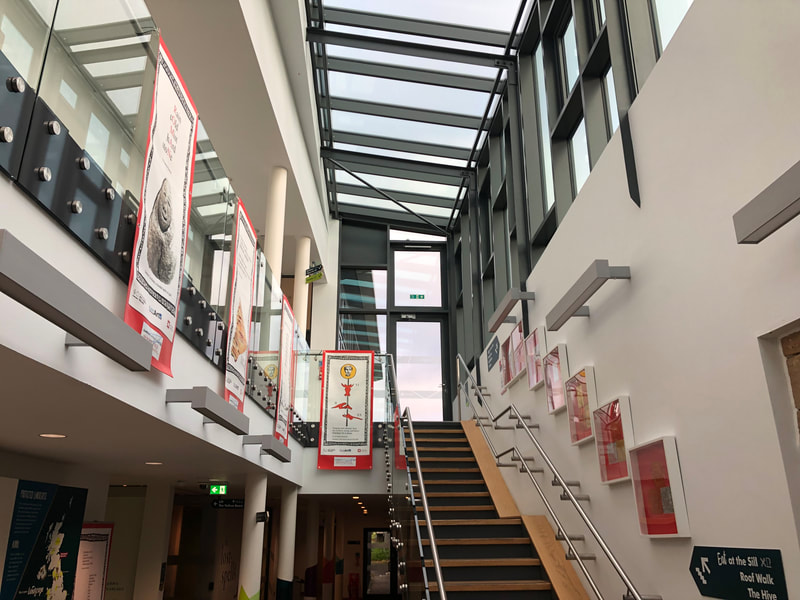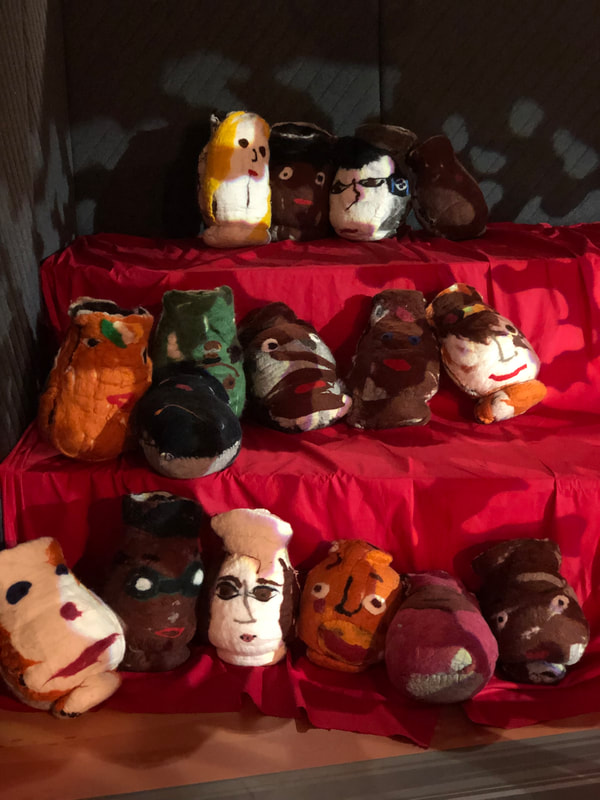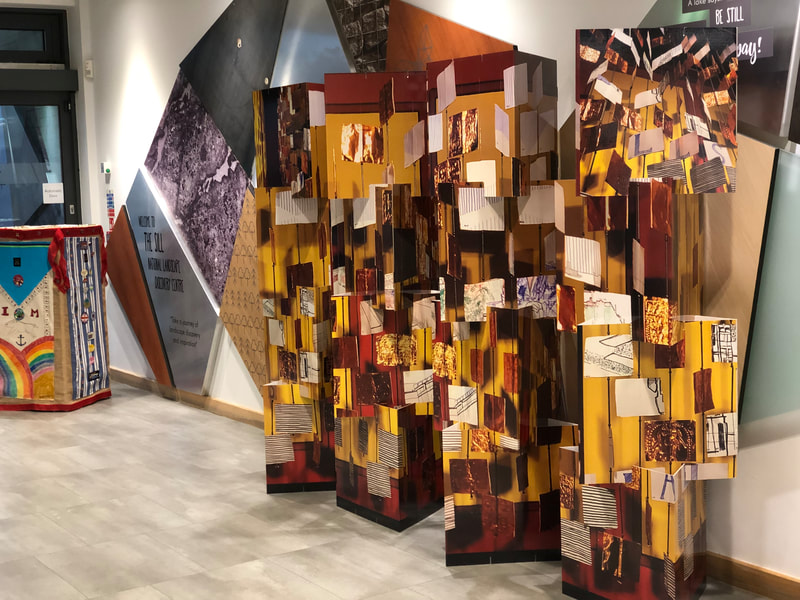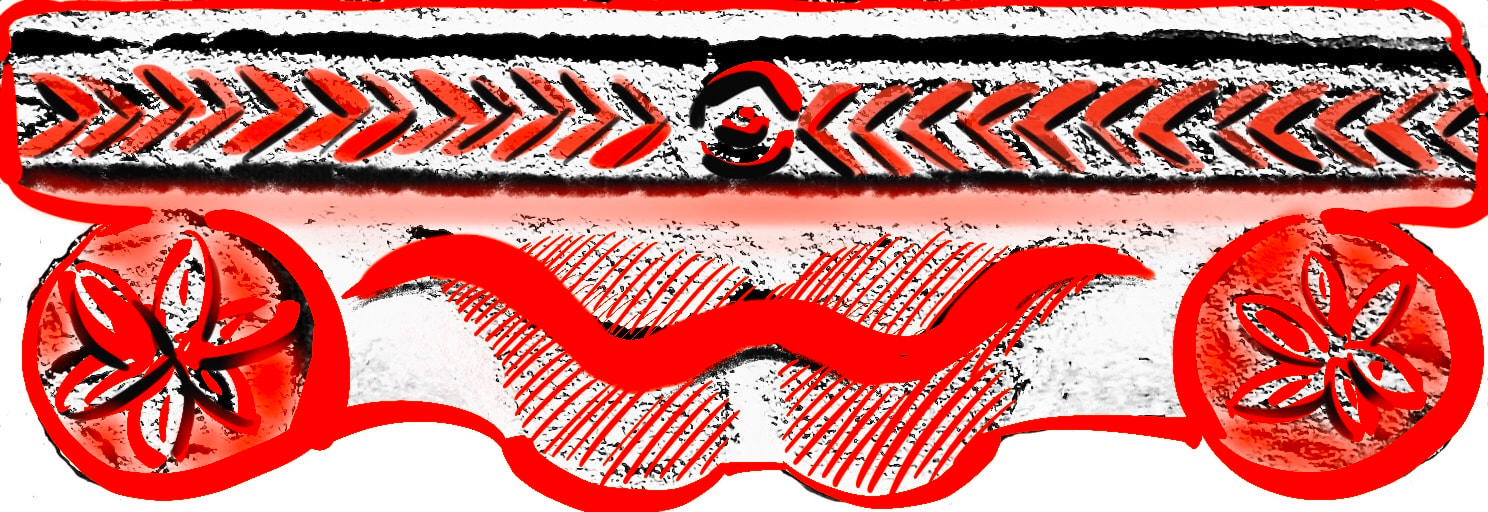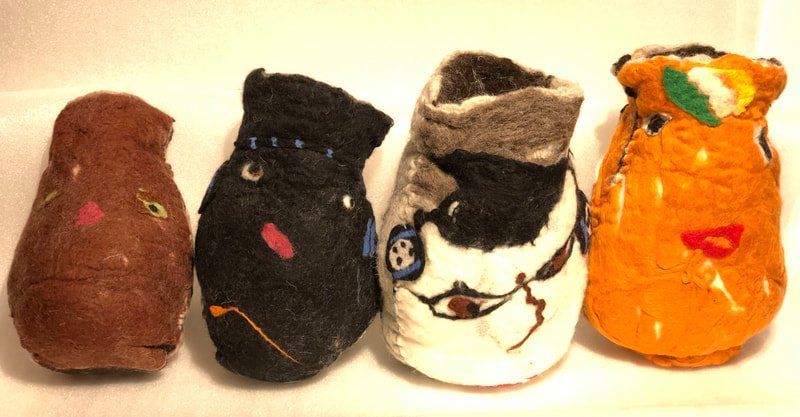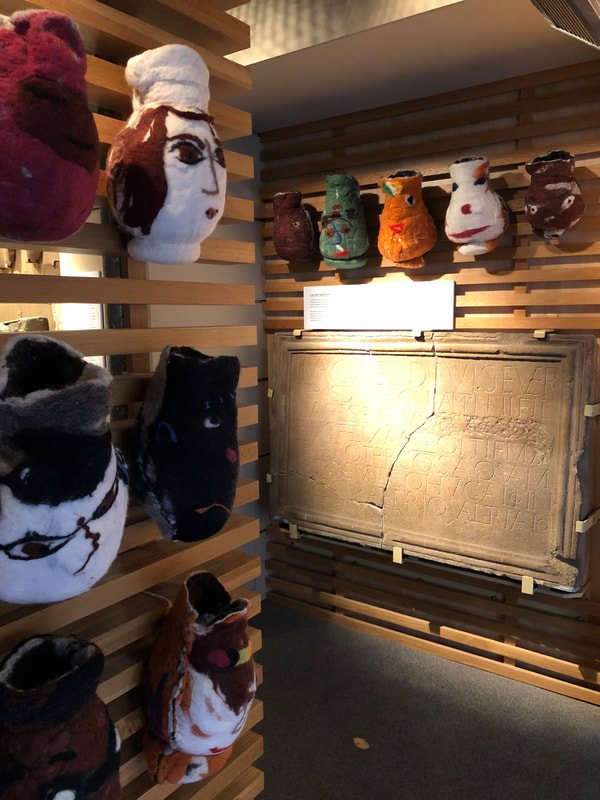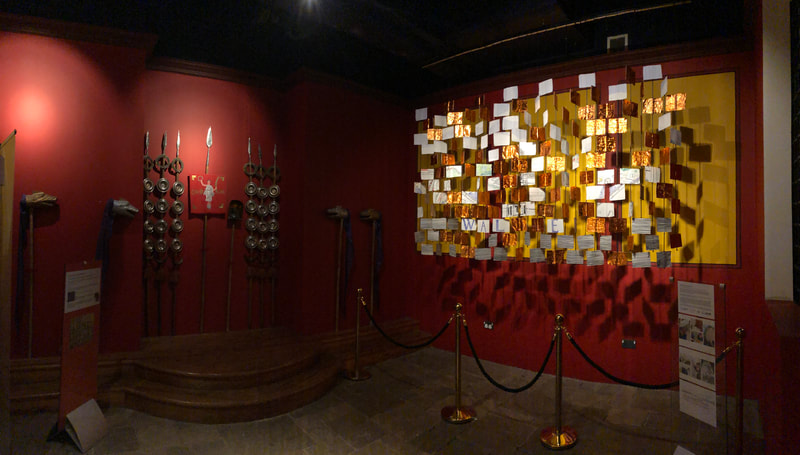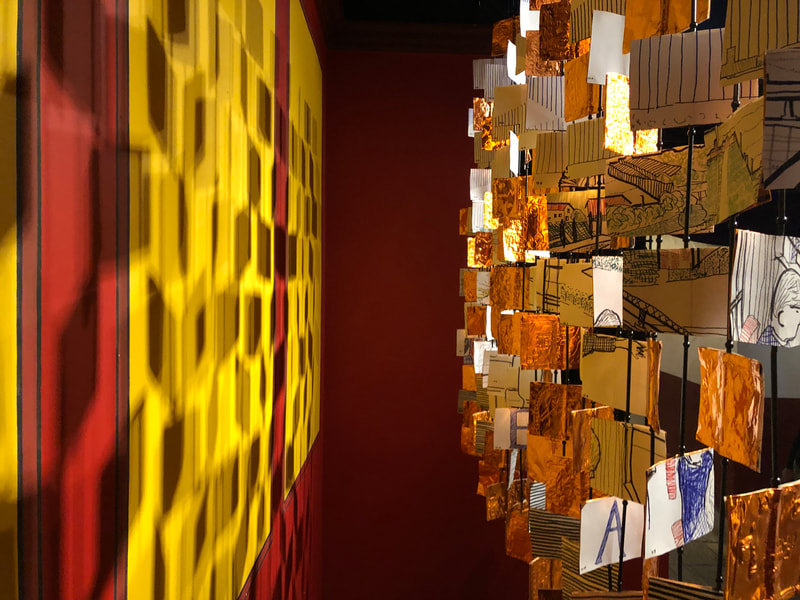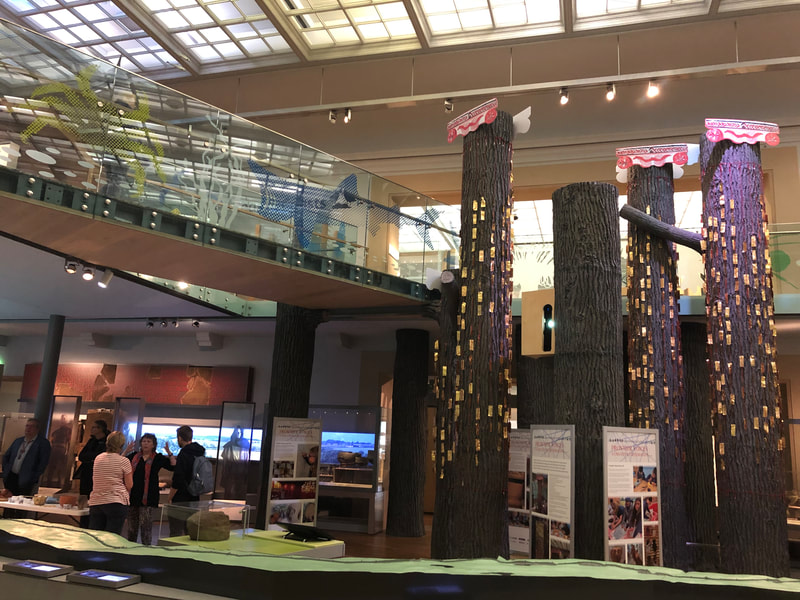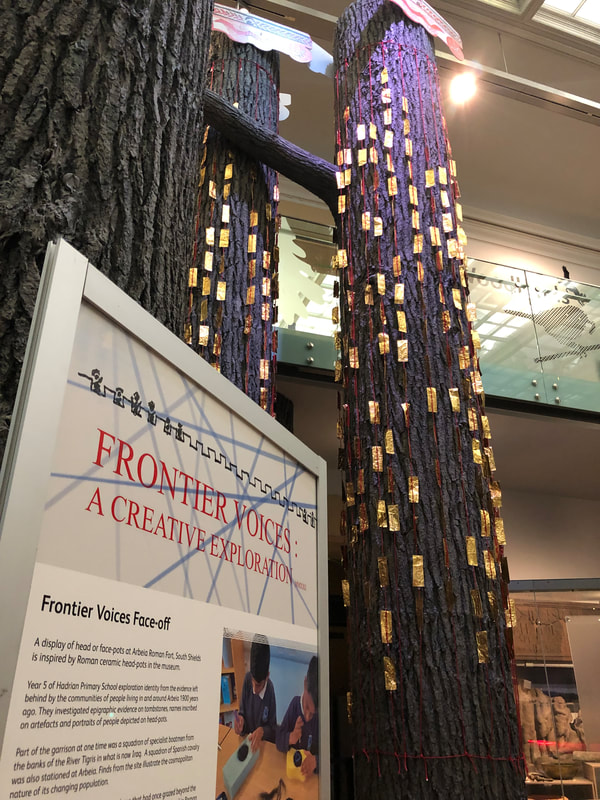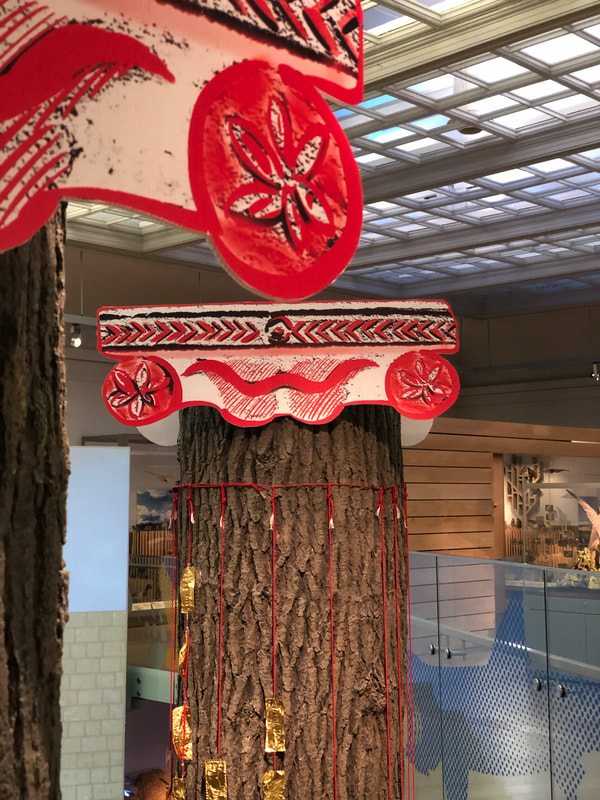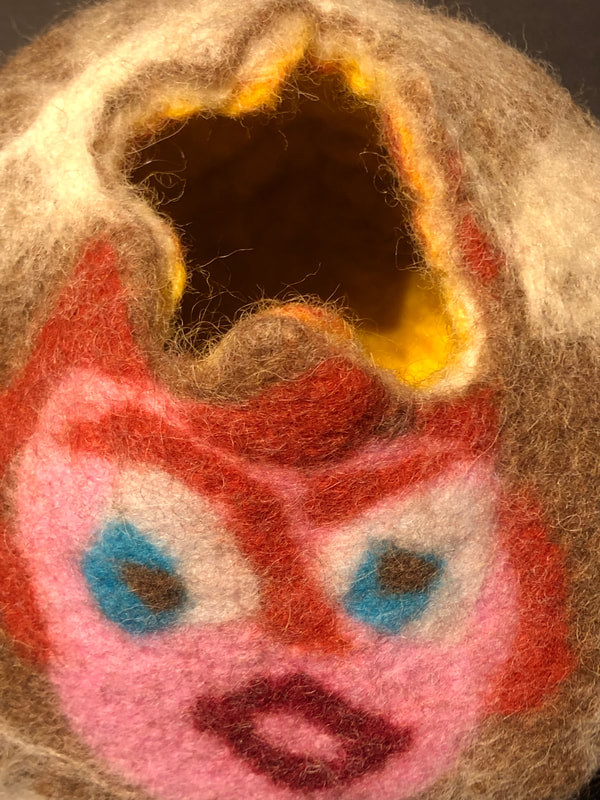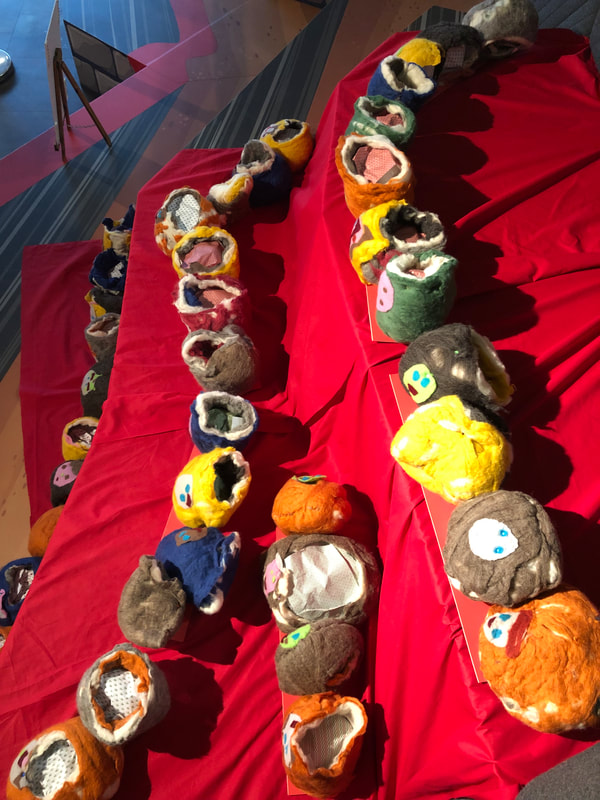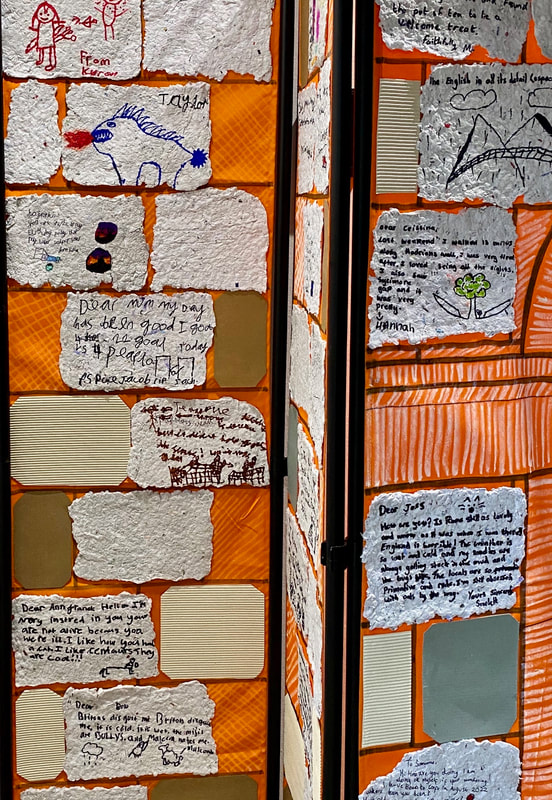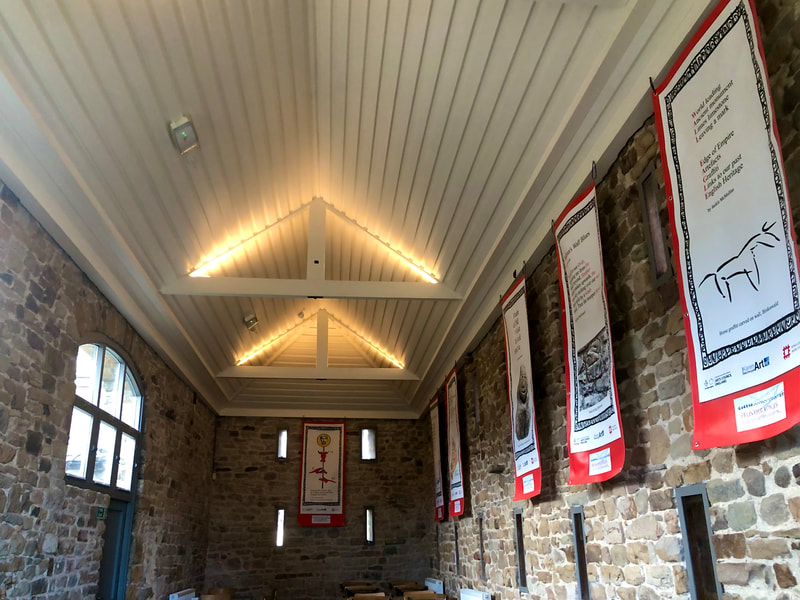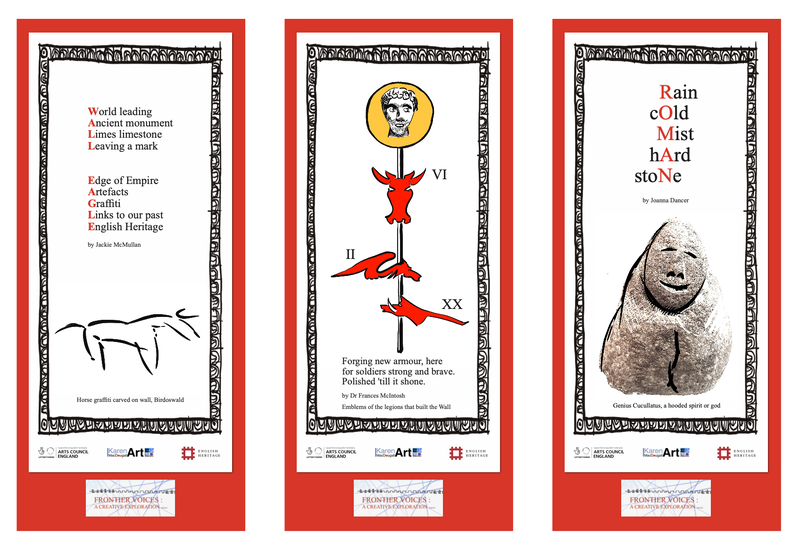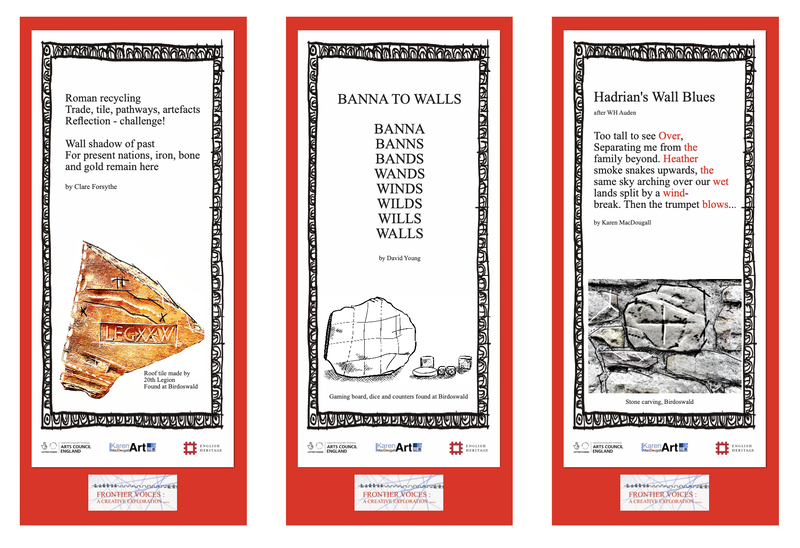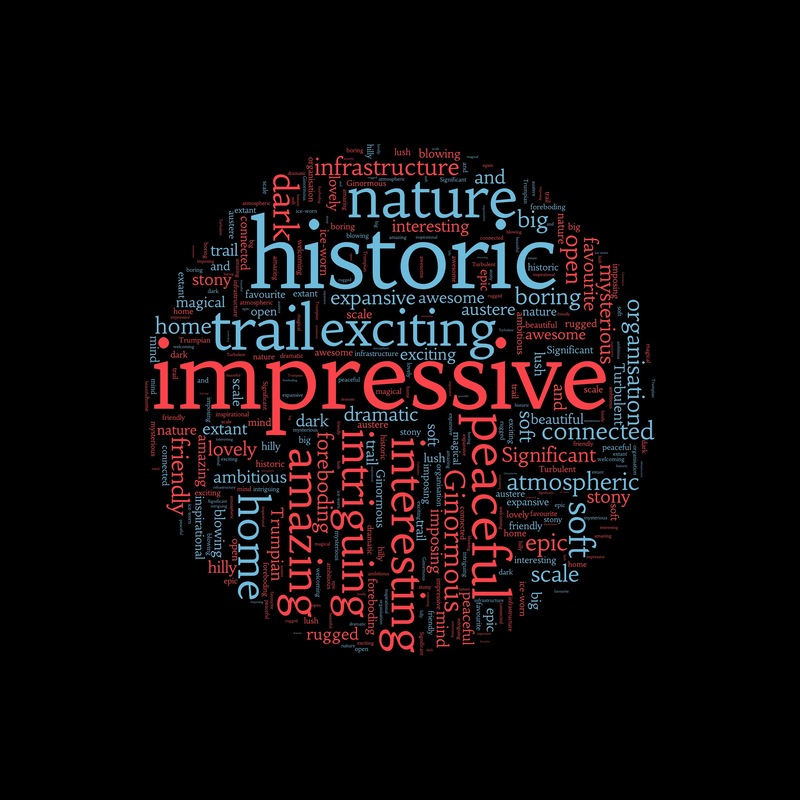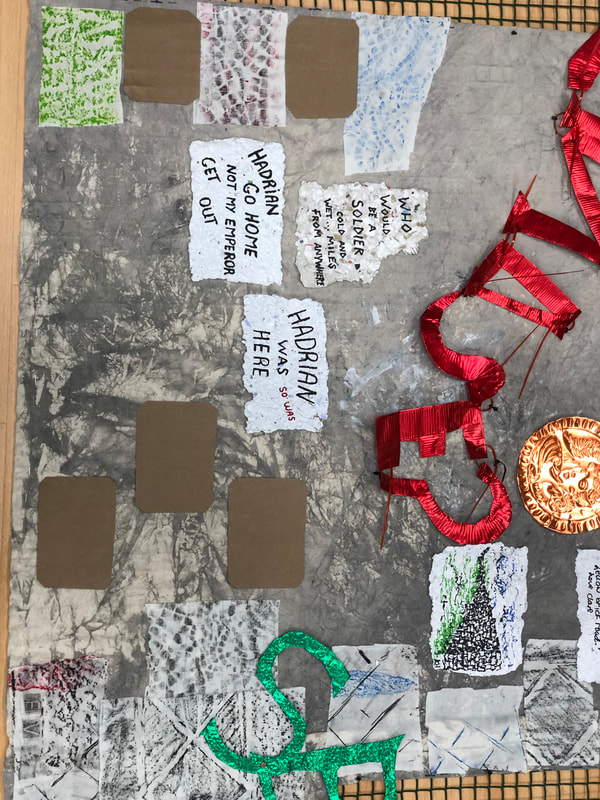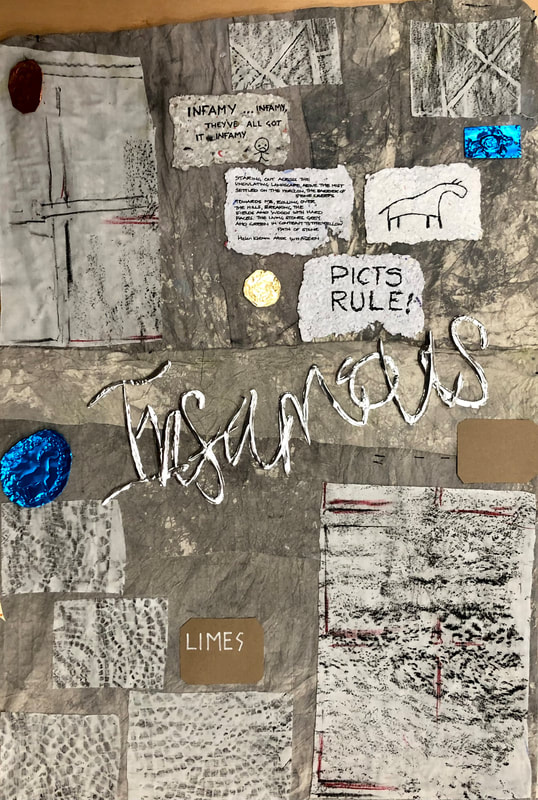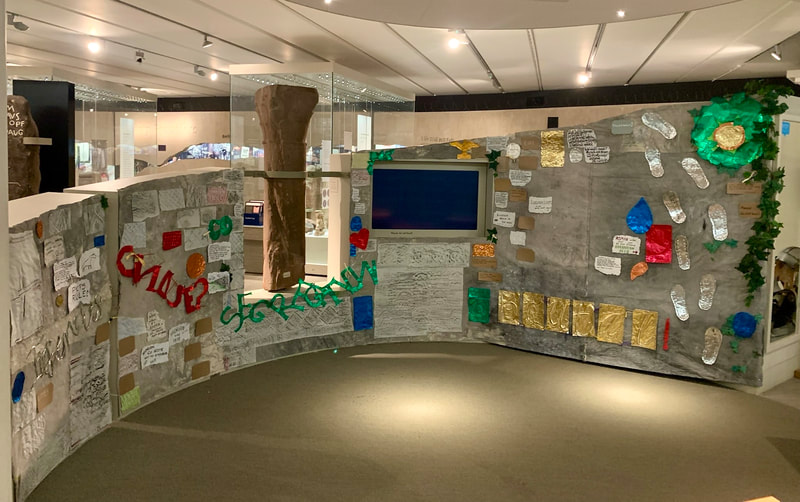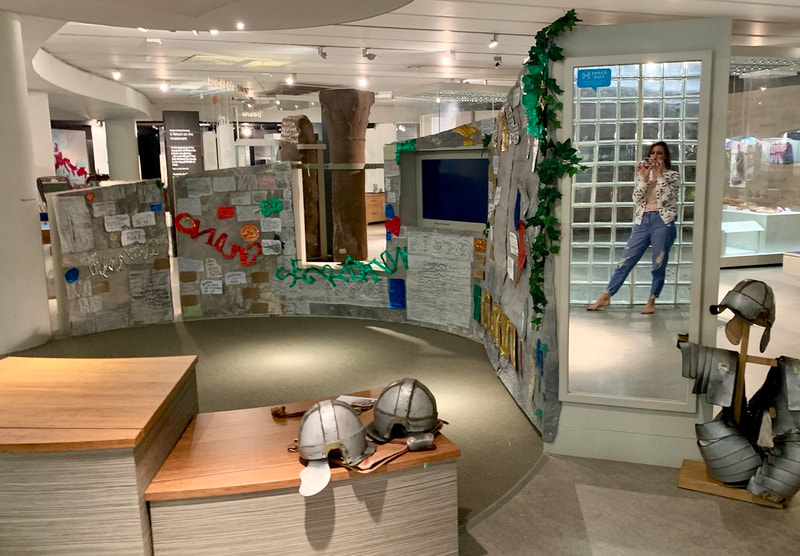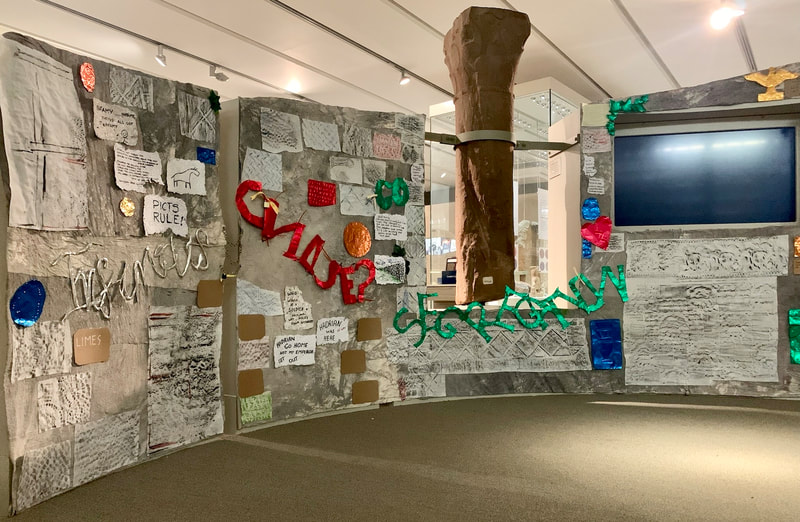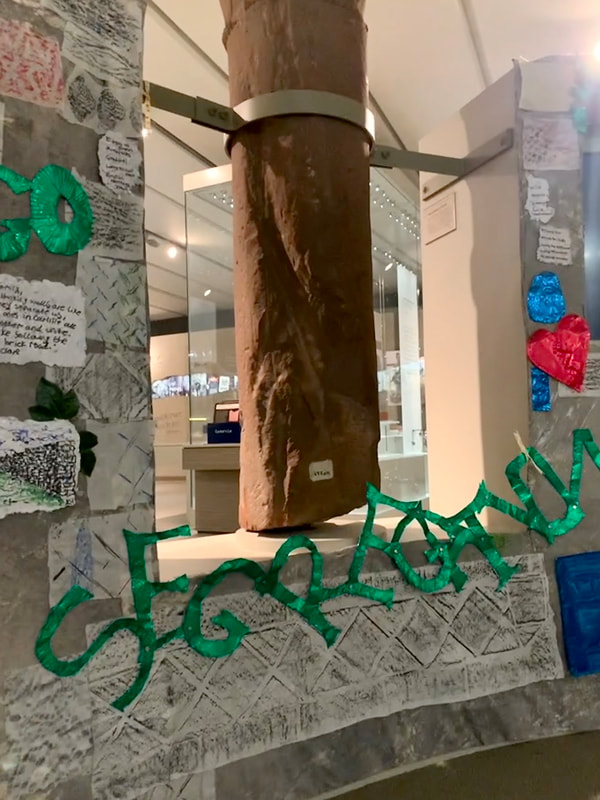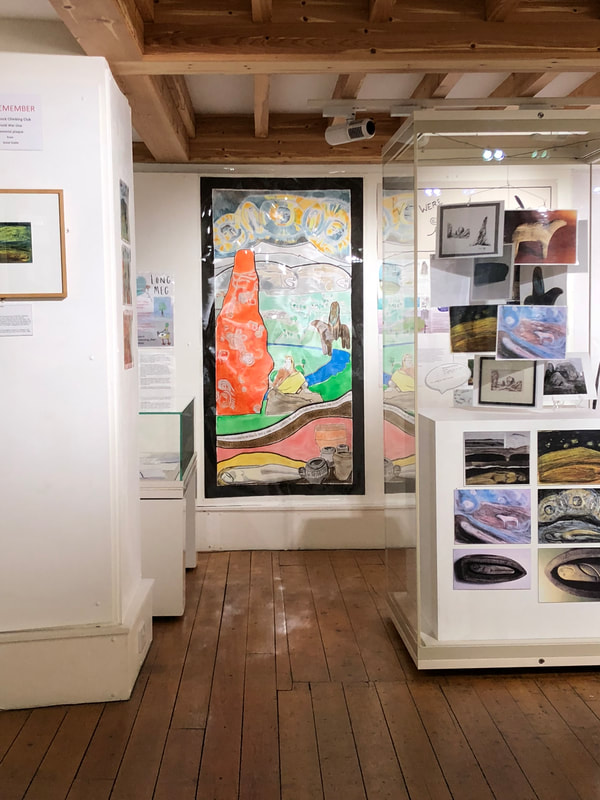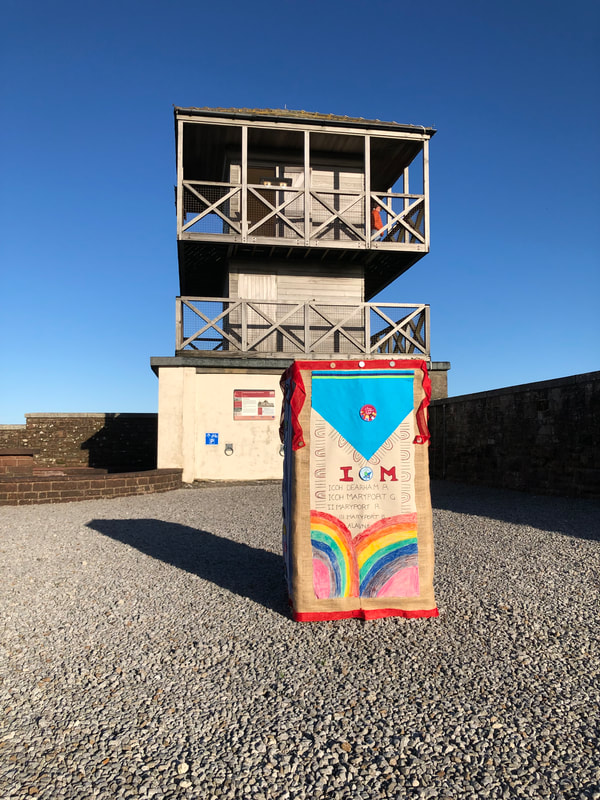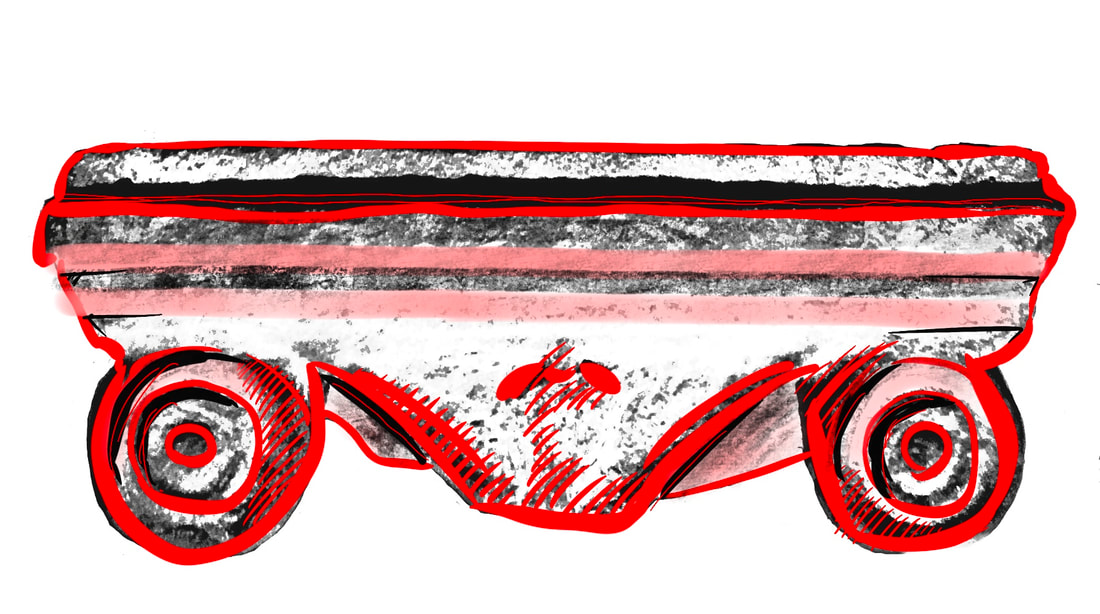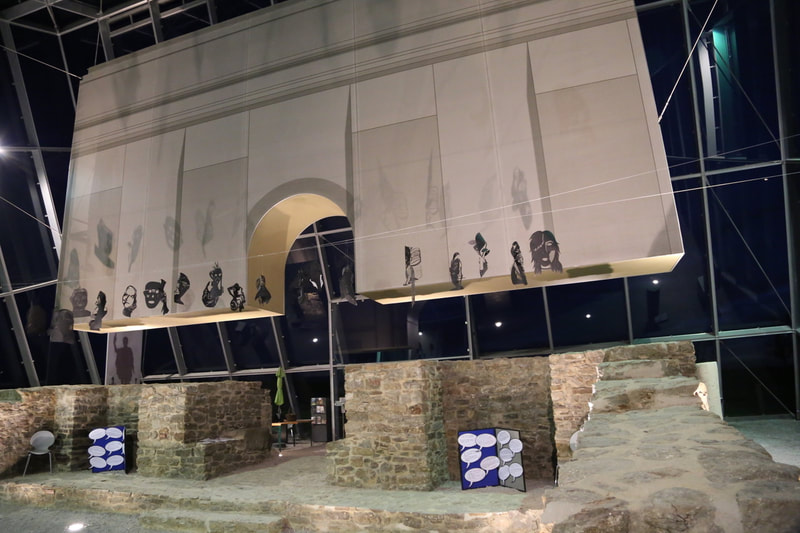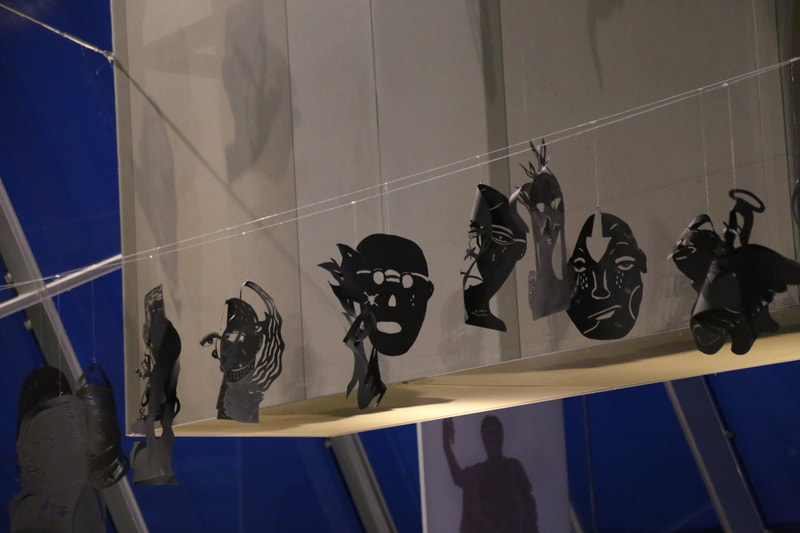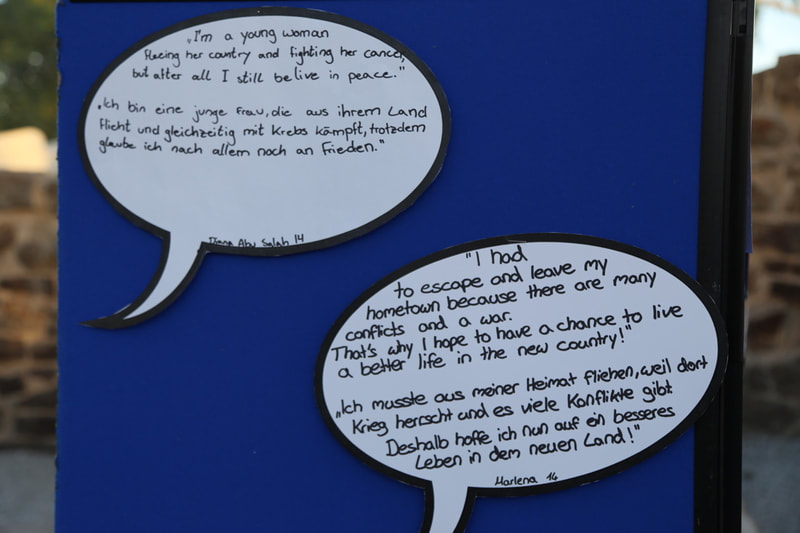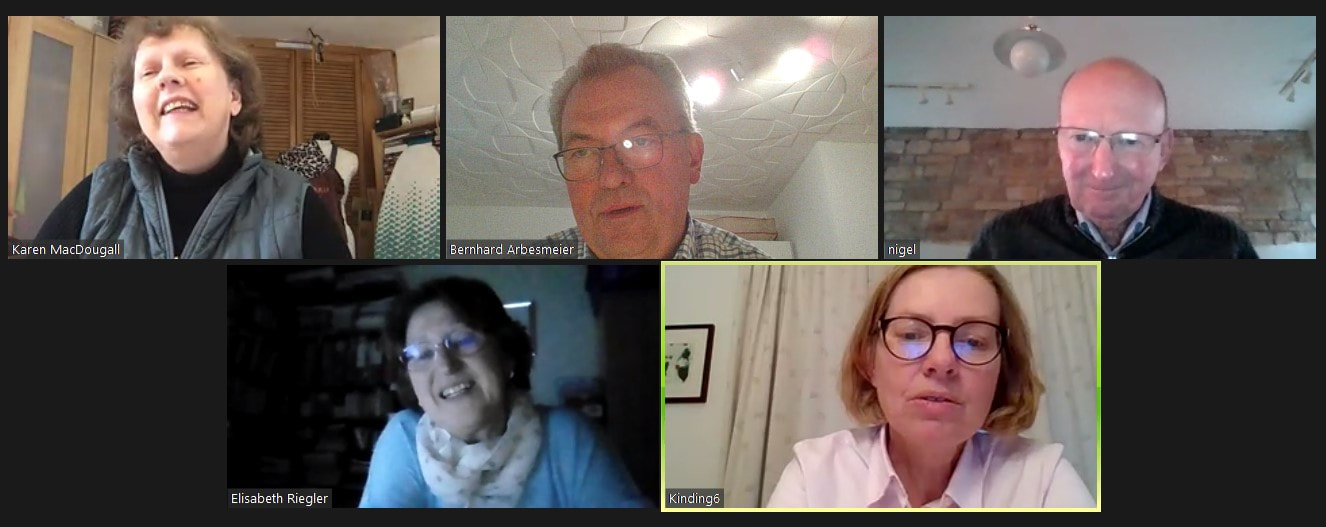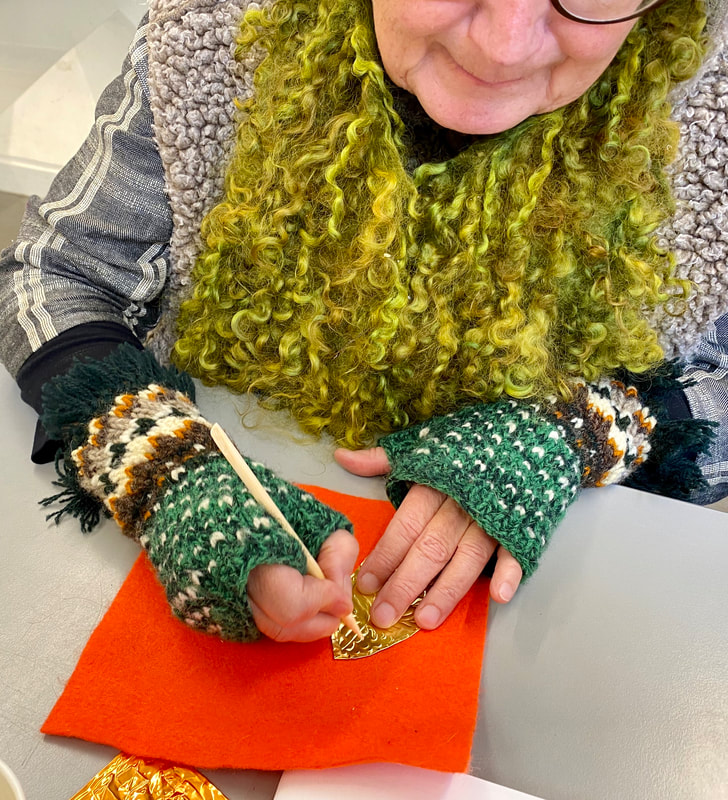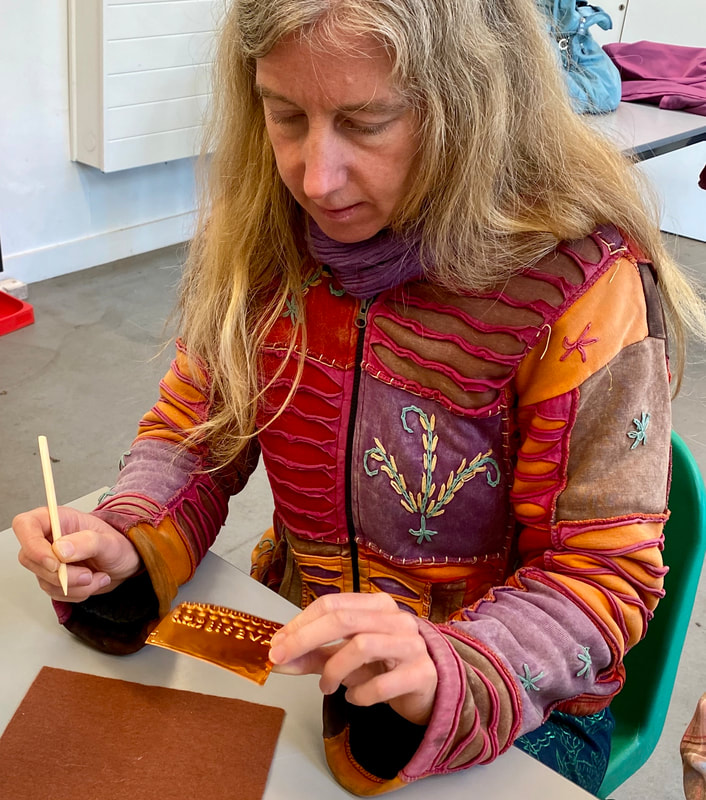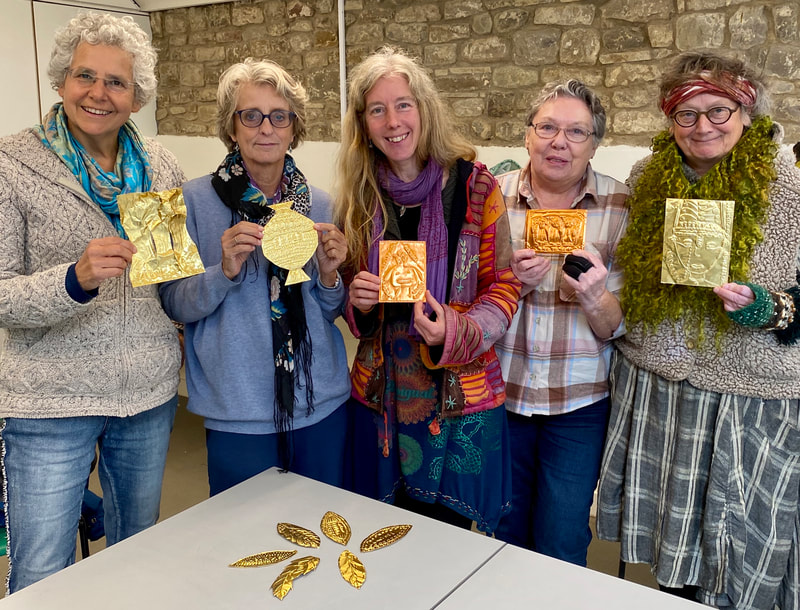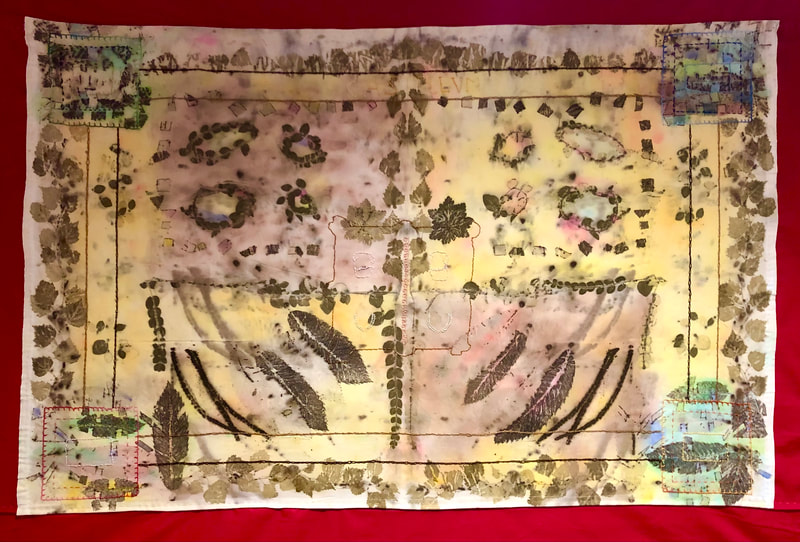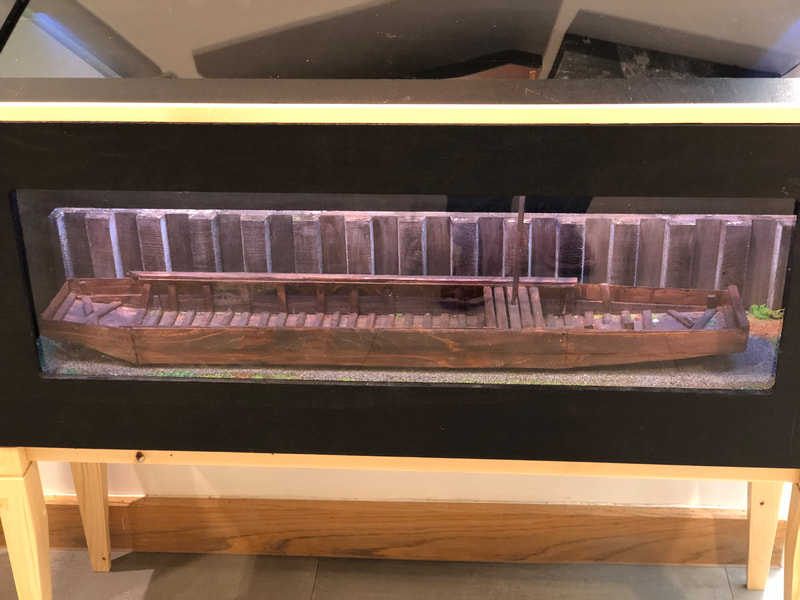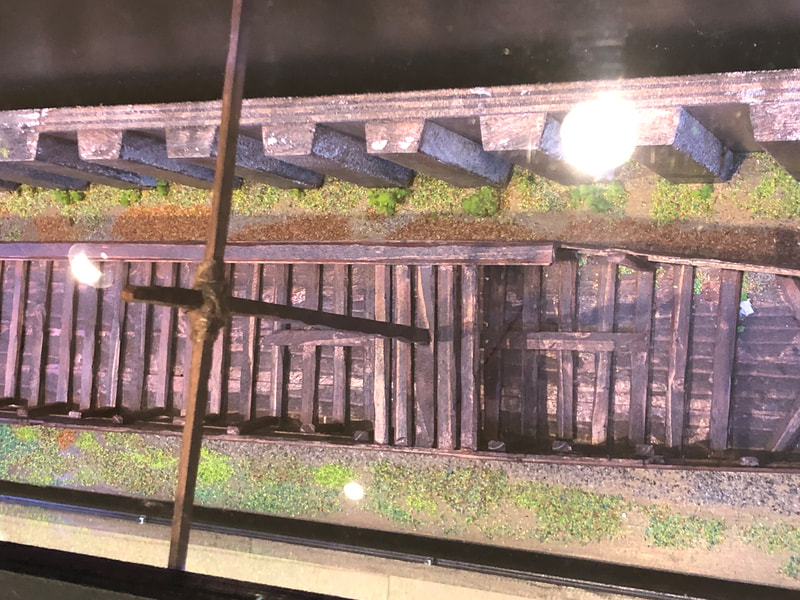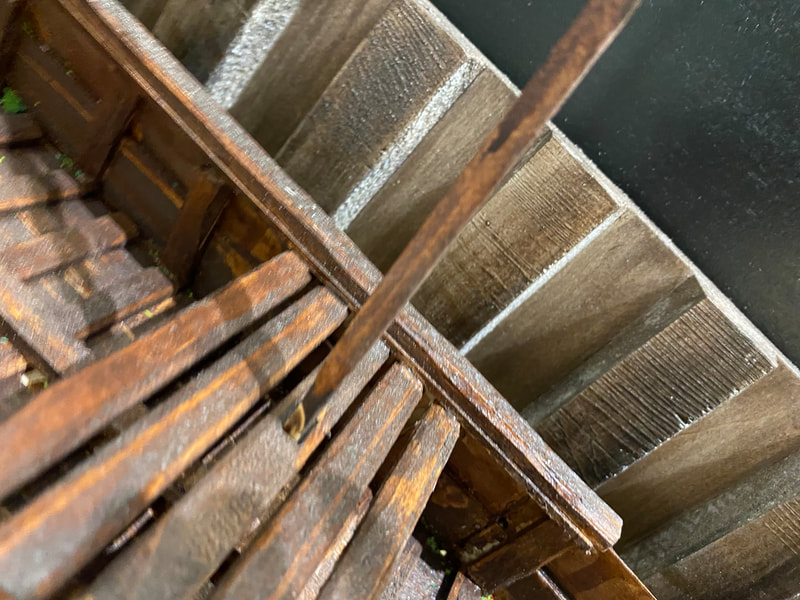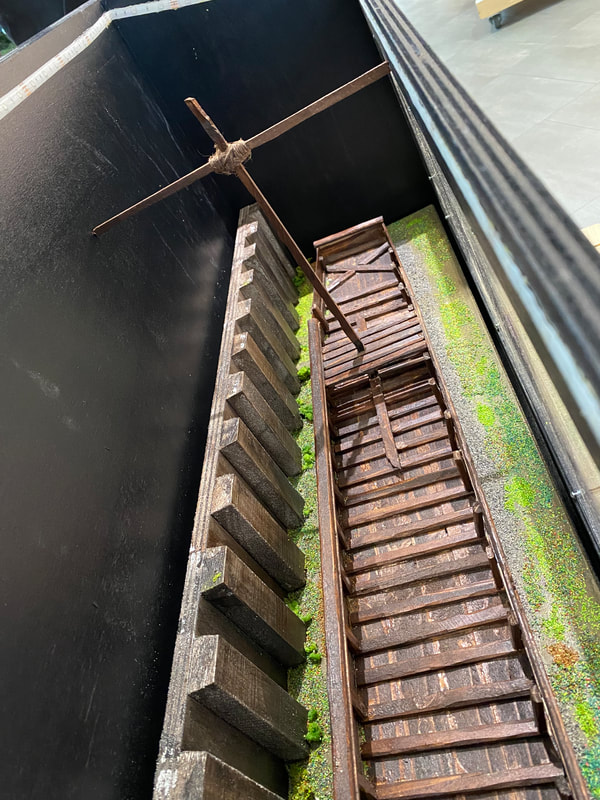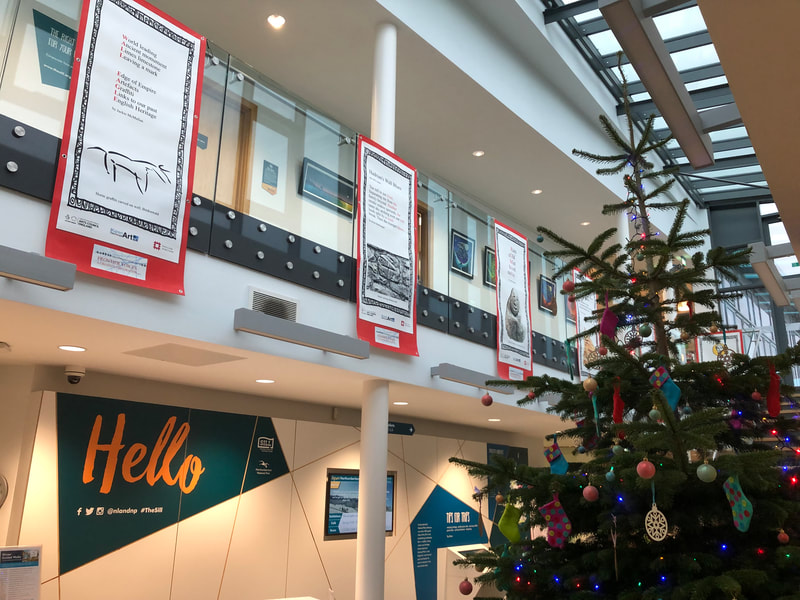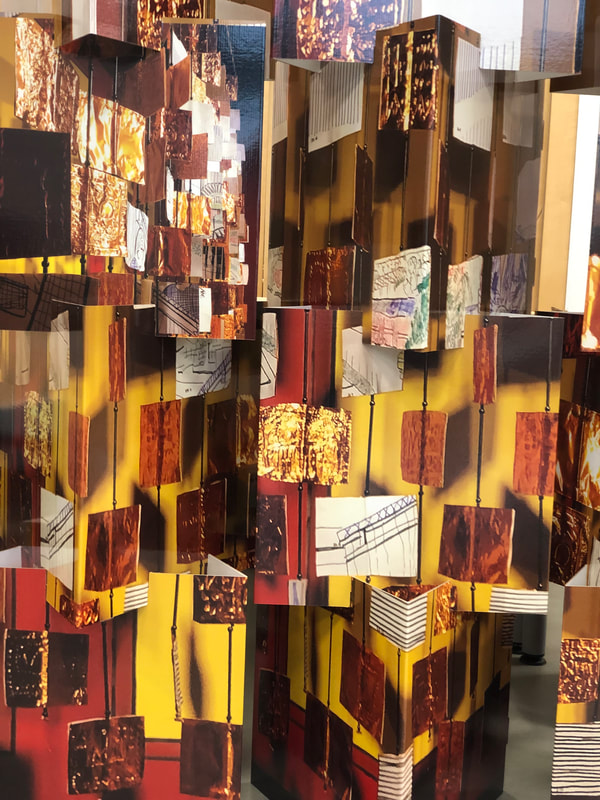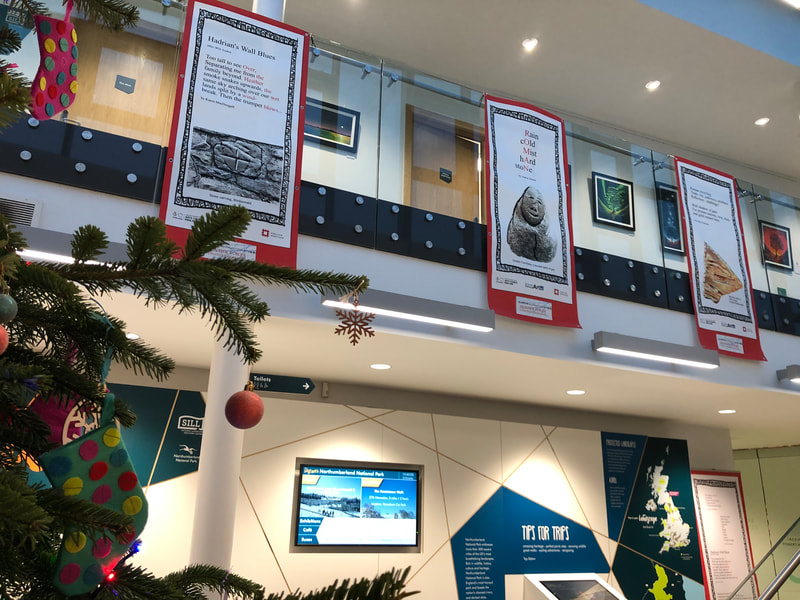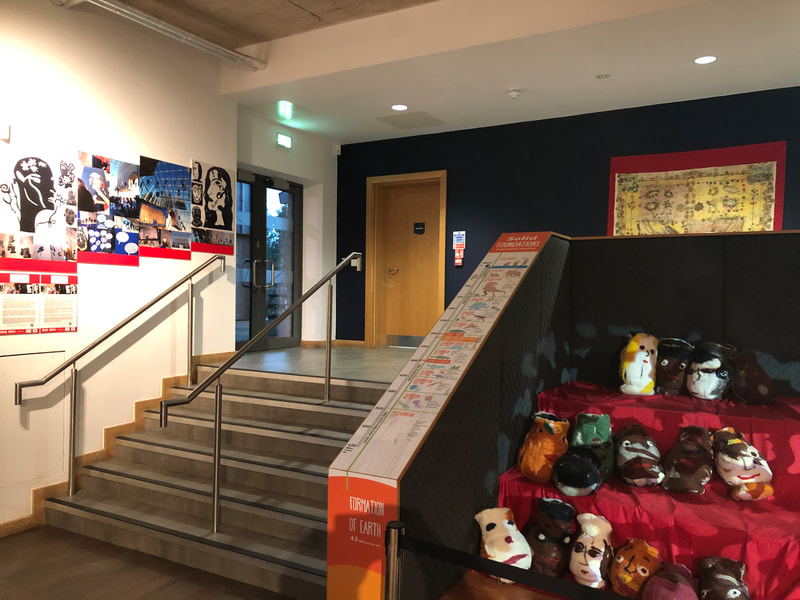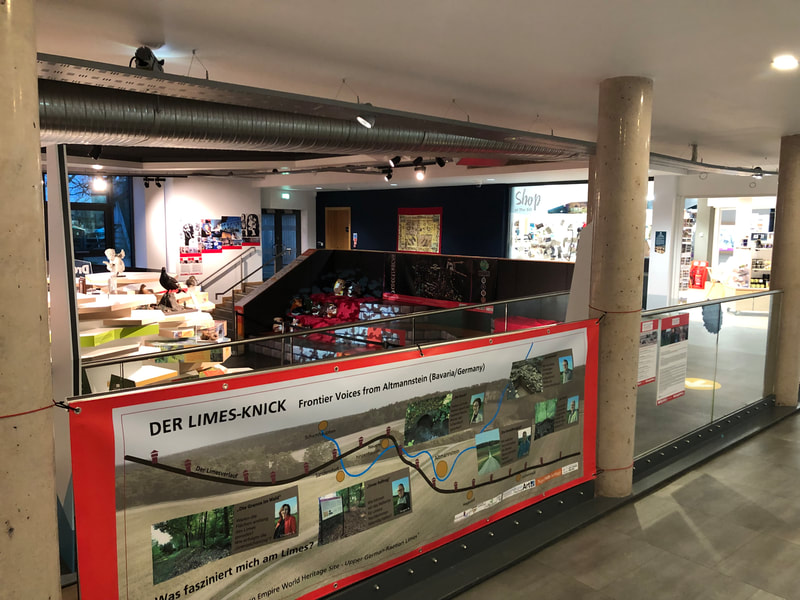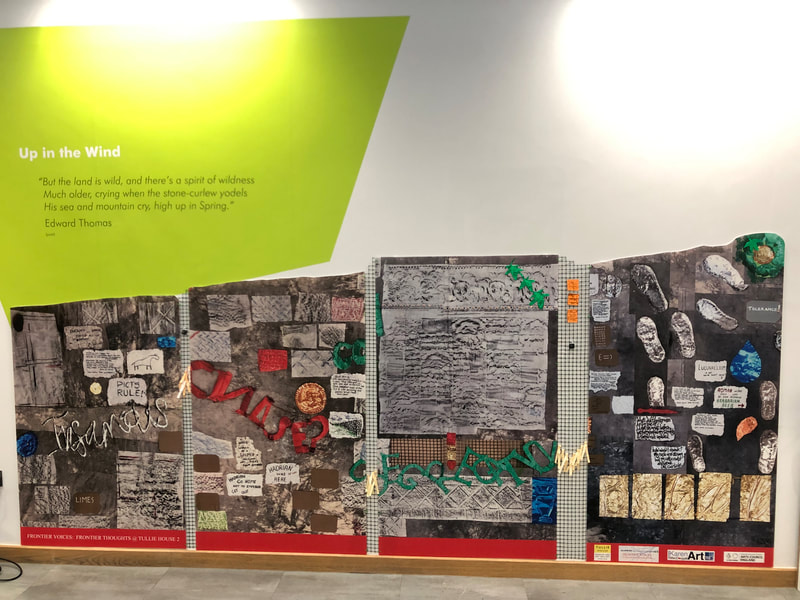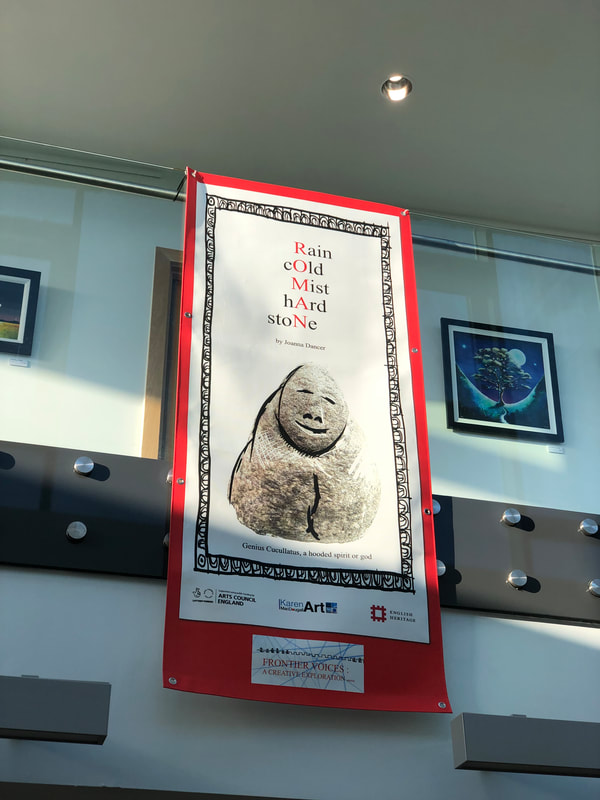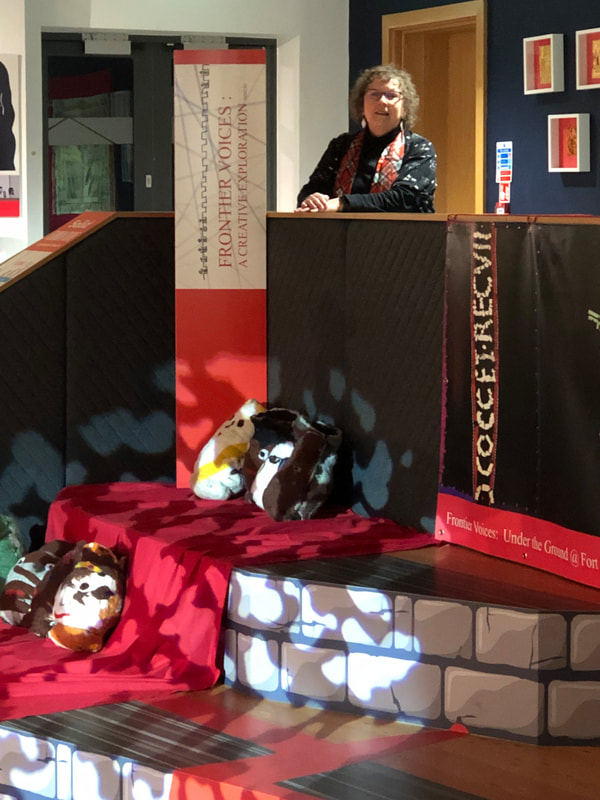Frontier Voices is an arts-based creative exploration of perceptions of Hadrian’s Wall UNESCO World Heritage sites and landscapes. Diverse groups of participants and communities along the Wall and at some of Europe’s Roman Frontiers have shared experiences and created artistic outcomes working together celebrating 1900 years of Hadrian’s Wall.
|
Artist Karen MacDougall has created bespoke artworks, working with communities at:
UK Locations all along Hadrian’s Frontier Borderlands Arbeia, South Shields Segedunum, Wallsend, Newcastle-upon-Tyne Great North Museum: Hancock, Newcastle-upon-Tyne Corbridge Roman Town, Corbridge, Northumberland Carrawburgh Fort, Temple of Mithras and Coventina’s Well, Newbrough, Northumberland Vindolanda, Hexham, Northumberland Roman Army Museum, Greenhead, Brampton Birdoswald, Gilsland, Cumbria Tullie House Museum and Gallery, Carlisle Senhouse Roman Museum, Maryport Germany German Limes: Peutinger Gymnasium, Ellwangen, Baden-Wurttemberg LimesGemeinden Communities, Raetian Limes, Bavaria. NetherlandsWestern Dutch Limes: Park Matilo (Leiden) NIGRVM PVLLVM (Zwammerdam) |
Karen has been assisted, particularly with the European projects, by heritage consultant Dr Nigel Mills. This project forms part of the Hadrian 1900 Festival and we are grateful to Arts Council England who have funded it and to the UK and European partners who have contributed in various ways to make Frontier Voices possible.
Exhibition at The Sill
The National Landscape Discovery Centre
1st December 2022 to 31st January 2023
Arbeia
A display of identity pots was installed at Arbeia Roman Fort, South Shields. These were created by Year 5 of Hadrian Primary School, working with artist Karen MacDougall, the Arbeia fort learning team and FV team. They were inspired by Roman ceramic head-pots, portraits of real Roman people who may have visited this Roman Frontier in Roman times.
| Arbeia | |
| File Size: | 1976 kb |
| File Type: | |
Segedunum
Installation artwork made specifically for The Shrine of the Standards at Segedunum Fort in Wallsend, inspired by Hadrian’s Wall 1900 years ago and the landscape at Wallsend today. The concept was created by artist Karen MacDougall, who worked with staff and students of Denbigh Community Primary School and the team at Segedunum.The participants captured the names of the centurions who were responsible for the construction of the Wall on embossed metal foil. These 'stones' were backed with sections of a large drawing reflecting Wallsend today. These were assembled into a large mobile so the stones could move independently in the gallery's air currents.It is possible, if you wait long enough that you will see either the Roman or today’s side of the stones but mostly it is a mosaic fusion of past and present. The past and present slowly shifts, stones moving by magic and projecting shadows onto the Shrine wall as the air moves in the space.
| Segedunum | |
| File Size: | 1744 kb |
| File Type: | |
Great North Museum
Loosely translated as, ‘I too am present in Arcadia’, the Roman poet Virgil wrote this in his Eclogues. There are various interpretations of his meaning, ‘I’ being death and our use of identity tags is one used by both Roman and today’s military to identify people.
Our identity tags were embossed on metal and completed by hundreds of visitors to the museum over half term, summer 2022 working with artist Karen MacDougall, the Frontier Voices team, members of GNM staff and museum volunteers. These identity tags, made by today’s Frontier Voices, are sharing the gallery with artefacts from the Romans who inhabited the area around Hadrian’s Wall 1900 years ago. This creates a tangible link between past and present visitors to the Roman Frontier through sharing the same physical space and eventual death.
The concept for the artwork is a drawing of columns. One of the really exciting things about this museum is the number of real artefacts from the length of Hadrian’s Wall. To create the column capital some of the Roman altars on display were explored and motifs used to create the design which was then printed onto board. Using the 'trees' already present in the gallery, this gave a perfect framework for the roman red lines and column heads with the identity tags adding shiny metal scales to the space not unlike the lorica segmentata of the armour.
Our identity tags were embossed on metal and completed by hundreds of visitors to the museum over half term, summer 2022 working with artist Karen MacDougall, the Frontier Voices team, members of GNM staff and museum volunteers. These identity tags, made by today’s Frontier Voices, are sharing the gallery with artefacts from the Romans who inhabited the area around Hadrian’s Wall 1900 years ago. This creates a tangible link between past and present visitors to the Roman Frontier through sharing the same physical space and eventual death.
The concept for the artwork is a drawing of columns. One of the really exciting things about this museum is the number of real artefacts from the length of Hadrian’s Wall. To create the column capital some of the Roman altars on display were explored and motifs used to create the design which was then printed onto board. Using the 'trees' already present in the gallery, this gave a perfect framework for the roman red lines and column heads with the identity tags adding shiny metal scales to the space not unlike the lorica segmentata of the armour.
| GNM: Hancock | |
| File Size: | 1857 kb |
| File Type: | |
Corbridge Roman Town
Concept by Karen MacDougall and the Frontier Voices team, working with staff from English Heritage and Northumberland Scouts and leaders. The Scouts had been set various discovery challenges at the museum, were invited to handle real and replica Roman pottery which included a number of artefacts with faces. The session was led by Dr Frances McIntosh, English Heritage’s Hadrian’s Wall curator. There was also a rolling presentation about the project Frontier Voices. This provided the context for our creative project designing and making a face- pot which reflects your identity in some way. The Romans used clay for these but to celebrate their sheep rearing skills along the Wall that provided meat and fibres for clothing, this became a felting identity challenge!
| Corbridge | |
| File Size: | 1467 kb |
| File Type: | |
Carrawburgh Fort
Concept by Karen MacDougall working with Dr Frances McIntosh and HW1900
Participants, today's Frontier Voices, created votive plaques to give thanks for something that was important to them. They were inspired by seeing Roman examples of those found in the Roman borderlands and then created their own for display in the café at Chesters Fort after the exhibition.
The Romans worshipped many gods and left behind large and small altars. The Mithraeum at Carrawburgh is a place where a secret Roman religion was worshipped, with its roots in the Middle East - evidence of the diversity of soldiers along the Wall. Corbridge Museum has some fantastic metalwork with the Corbridge Lanx showing Roman Gods. Metal plaques were another art form where thanks was given or a bargain made to be thanked for later when the good fortune occurred, eg. after a safe journey to Britain from Rome. Dr Frances McIntosh introduced these ideas to a group of Hadrian’s Wall Volunteers who had worked on the 1900 Festival . They saw lots of examples, different shapes, sizes and metal types with both detailed and also quite crude designs, which had been found in the Borderlands near the Wall.
Participants, today's Frontier Voices, created votive plaques to give thanks for something that was important to them. They were inspired by seeing Roman examples of those found in the Roman borderlands and then created their own for display in the café at Chesters Fort after the exhibition.
The Romans worshipped many gods and left behind large and small altars. The Mithraeum at Carrawburgh is a place where a secret Roman religion was worshipped, with its roots in the Middle East - evidence of the diversity of soldiers along the Wall. Corbridge Museum has some fantastic metalwork with the Corbridge Lanx showing Roman Gods. Metal plaques were another art form where thanks was given or a bargain made to be thanked for later when the good fortune occurred, eg. after a safe journey to Britain from Rome. Dr Frances McIntosh introduced these ideas to a group of Hadrian’s Wall Volunteers who had worked on the 1900 Festival . They saw lots of examples, different shapes, sizes and metal types with both detailed and also quite crude designs, which had been found in the Borderlands near the Wall.
| Carrawburgh | |
| File Size: | 1240 kb |
| File Type: | |
Vindolanda
Concept by artist Karen MacDougall. Postcards made by Beavers, Cubs and Scouts of Allen Valleys Scouts, working with Karen and the FV team with staff from Vindolanda.
We know that the Romans recycled and repurposed many things...deities, materials, tools, etc. Thinking about modern issues of climate change, recycling and repurposing we made paper postcards from Vindolanda’s shredded paper waste and then wrote postcards relevant to today, inspired by the Vindolanda tablets. Roman Frontier Voices were discovered with a visit to the site at Vindolanda. The young people completed activities, visited the replica watchtower, listened to replica Roman musical instruments and explored the museum. They were particularly fascinated by the Vindolanda tablets, which provided first-hand evidence of real Roman people living at the Frontier and snapshots of their lives. They also shared in the story of the Frontier Voices project so far, its link to UNESCO core values, before creating and embossing metal ‘identity’ leaves for the art installation at the Sill.
Using shredded office waste from the Vindolanda Trust, and by ‘shake, rattle and roll’, we pulped, sieved and shaped it into rectangles and left it to dry. When the recycled postcards were ready for use, Barbara Birley, curator of Vindolanda, shared replicas of artefacts from the site, including the Vindolanda tablets, which we discussed. The participants were then challenged to write their own postcards as today’s Frontier Voices - what would matter to them? shopping lists? texting friends? getting inside the heads of the Romans? This is their personal interpretation - their
Frontier Voices - inspired by their visit to Hadrian’s Frontier.
Karen then created the gateway. Roman milecastles had provided people access, as well as controlling goods and information flow, so here our Gateway gives us access to thoughts and ideas from the Beavers, Cubs and Scouts of today.
We know that the Romans recycled and repurposed many things...deities, materials, tools, etc. Thinking about modern issues of climate change, recycling and repurposing we made paper postcards from Vindolanda’s shredded paper waste and then wrote postcards relevant to today, inspired by the Vindolanda tablets. Roman Frontier Voices were discovered with a visit to the site at Vindolanda. The young people completed activities, visited the replica watchtower, listened to replica Roman musical instruments and explored the museum. They were particularly fascinated by the Vindolanda tablets, which provided first-hand evidence of real Roman people living at the Frontier and snapshots of their lives. They also shared in the story of the Frontier Voices project so far, its link to UNESCO core values, before creating and embossing metal ‘identity’ leaves for the art installation at the Sill.
Using shredded office waste from the Vindolanda Trust, and by ‘shake, rattle and roll’, we pulped, sieved and shaped it into rectangles and left it to dry. When the recycled postcards were ready for use, Barbara Birley, curator of Vindolanda, shared replicas of artefacts from the site, including the Vindolanda tablets, which we discussed. The participants were then challenged to write their own postcards as today’s Frontier Voices - what would matter to them? shopping lists? texting friends? getting inside the heads of the Romans? This is their personal interpretation - their
Frontier Voices - inspired by their visit to Hadrian’s Frontier.
Karen then created the gateway. Roman milecastles had provided people access, as well as controlling goods and information flow, so here our Gateway gives us access to thoughts and ideas from the Beavers, Cubs and Scouts of today.
| Vindolanda | |
| File Size: | 1331 kb |
| File Type: | |
Roman Army Museum
Concept by Karen MacDougall. Artwork created by Haltwhistle Youth Club (Young and Sweet) and their leaders, working with Karen, staff from the Vindolanda Trust and FV assistant Clare Forsythe.
An awareness-raising mosaic artwork was created using pieces of waste material, based on a geophysical survey of the fort site. Climate change is causing the ground to dry out, which means that precious artefacts and information are being lost. We need to act now!
The project started with an inspirational visit to the Roman Army Museum and Fort Magna site. We then ran a number of sessions at the youth club's base in Haltwhistle to create the artwork. The recycled materials included egg boxes, milk bottle tops and margarine tubs to fabric and metal foil offcuts from other Frontier Voices Projects. The original artwork will be on permanent display at the Haltwhistle Youth Club. The banners are on display at the Roman Army Museum and Vindolanda.
An awareness-raising mosaic artwork was created using pieces of waste material, based on a geophysical survey of the fort site. Climate change is causing the ground to dry out, which means that precious artefacts and information are being lost. We need to act now!
The project started with an inspirational visit to the Roman Army Museum and Fort Magna site. We then ran a number of sessions at the youth club's base in Haltwhistle to create the artwork. The recycled materials included egg boxes, milk bottle tops and margarine tubs to fabric and metal foil offcuts from other Frontier Voices Projects. The original artwork will be on permanent display at the Haltwhistle Youth Club. The banners are on display at the Roman Army Museum and Vindolanda.
| Roman Army Museum | |
| File Size: | 2120 kb |
| File Type: | |
Birdoswald
Interpretations of Birdoswald in words and images.
A collection of poems was created in 4 workshops held at Birdoswald Fort, led by artist Karen MacDougall and FV assistant Clare Forsythe.
Dr Frances McIntosh and Helen Klemm of English Heritage gave a perspective on the history, shared artefacts with the group and joined in the creative writing. David Young, volunteer with Northumberland National Park, told us about the landscape and geology of the area. Other Wall volunteers shared their views and there was lots of discussion during the workshop, hints of which are captured in the selected poems. Over the weekend, we explored descriptions, acrostics, haikus, word metamorphoses, mesostics and golden-shovel formats. Additionally, we sought the opinions of visitors, who were at Birdoswald or walking the Wall nearby. This is captured in the word art, where repeated words appear larger showing a consensus amongst visitors. Karen selected poems that related to specific Birdoswald artefacts and incorporated them into the artwork used to create 6 Banners, located in the Café Annexe at Birdoswald and chose those included in a separately published anthology.
A collection of poems was created in 4 workshops held at Birdoswald Fort, led by artist Karen MacDougall and FV assistant Clare Forsythe.
Dr Frances McIntosh and Helen Klemm of English Heritage gave a perspective on the history, shared artefacts with the group and joined in the creative writing. David Young, volunteer with Northumberland National Park, told us about the landscape and geology of the area. Other Wall volunteers shared their views and there was lots of discussion during the workshop, hints of which are captured in the selected poems. Over the weekend, we explored descriptions, acrostics, haikus, word metamorphoses, mesostics and golden-shovel formats. Additionally, we sought the opinions of visitors, who were at Birdoswald or walking the Wall nearby. This is captured in the word art, where repeated words appear larger showing a consensus amongst visitors. Karen selected poems that related to specific Birdoswald artefacts and incorporated them into the artwork used to create 6 Banners, located in the Café Annexe at Birdoswald and chose those included in a separately published anthology.
Tullie House
Frontier Thoughts @ Tullie House 1 is the original artwork on display at Tullie House Museum and Art Gallery in the Roman Frontier Gallery.
Frontier Thoughts @ Tullie House 2 is a photomontage of the original work with variations, on display at The Sill National Landscape Discovery Centre during the Frontier Voices Exhibition.
Concept by artist Karen MacDougall. Artwork made by members of the Tullie House Art Group, working with Karen, staff from Tullie House and English Heritage.
Borders and Frontiers mean different things to the people on either side. We explored identity, the Romans and the Celts 1900 year ago and ourselves here and now. There was much debate on the Wall and what it achieved and how frontiers shape our lives today. We visited Tullie House’s Roman galleries and imagined Carlisle as a Roman town. We contrasted this by visiting Birdoswald Fort and handling Roman artefacts. We saw the Wall marching across the landscape and were inspired. We chose words, wrote postcards recycled from the Vindolanda project, chose poems from the Birdoswald poetry project and celebrated popular culture today with song lyrics relating to walls, learned how to emboss metal foil and added found objects symbolic of love and loss. Add to this representations of Roman coins and phalera, exposed meshing stopping entry beyond and the yellow ribbons of loss as our work incorporates more modern themes.This wall is a culmination of our Frontier journey.
Frontier Thoughts @ Tullie House 2 is a photomontage of the original work with variations, on display at The Sill National Landscape Discovery Centre during the Frontier Voices Exhibition.
Concept by artist Karen MacDougall. Artwork made by members of the Tullie House Art Group, working with Karen, staff from Tullie House and English Heritage.
Borders and Frontiers mean different things to the people on either side. We explored identity, the Romans and the Celts 1900 year ago and ourselves here and now. There was much debate on the Wall and what it achieved and how frontiers shape our lives today. We visited Tullie House’s Roman galleries and imagined Carlisle as a Roman town. We contrasted this by visiting Birdoswald Fort and handling Roman artefacts. We saw the Wall marching across the landscape and were inspired. We chose words, wrote postcards recycled from the Vindolanda project, chose poems from the Birdoswald poetry project and celebrated popular culture today with song lyrics relating to walls, learned how to emboss metal foil and added found objects symbolic of love and loss. Add to this representations of Roman coins and phalera, exposed meshing stopping entry beyond and the yellow ribbons of loss as our work incorporates more modern themes.This wall is a culmination of our Frontier journey.
Tullie House installation photos by Tullie House
| Tullie House | |
| File Size: | 2352 kb |
| File Type: | |
Senhouse Roman Museum
The altar workshop was led by Karen, working with staff from the Senhouse Roman Museum Maryport, local Rainbows, Brownies and Guides and their leaders from GirlGuiding Cumbria North, and FV assistant Clare Forsythe.
Roman Frontier voices were discovered with a visit to the archaeological site at Senhouse Roman Museum. The young people visited the fort, completed activities, saw the replica watchtower and explored the museum. They discovered what UNESCO meant and they saw all the Frontier Voice art projects already completed. They were impressed by the number of altars, which provided first-hand evidence of real Roman people living on this Northern frontier. The Great North Museum's new altar installation inspired the use of bright colours. These provided the context for our creative project designing and making a modern altar for the museum.
Everyone worked together to design and create the new altar, which linked them to GirlGuiding’s values by incorporating part of the Promise along with some of the activity and special challenge badges within the altar design. True to the spirit of GirlGuiding this is a fantastic collaborative artwork.
Roman Frontier voices were discovered with a visit to the archaeological site at Senhouse Roman Museum. The young people visited the fort, completed activities, saw the replica watchtower and explored the museum. They discovered what UNESCO meant and they saw all the Frontier Voice art projects already completed. They were impressed by the number of altars, which provided first-hand evidence of real Roman people living on this Northern frontier. The Great North Museum's new altar installation inspired the use of bright colours. These provided the context for our creative project designing and making a modern altar for the museum.
Everyone worked together to design and create the new altar, which linked them to GirlGuiding’s values by incorporating part of the Promise along with some of the activity and special challenge badges within the altar design. True to the spirit of GirlGuiding this is a fantastic collaborative artwork.
| Senhouse | |
| File Size: | 1895 kb |
| File Type: | |
German Limes:
Peutinger Gymnasium, Ellwangen, Baden-Wurttemberg
Artwork made by Year 9 students of Peutinger - Gymnasium, Ellwangen. Photographs by Silke Schwab-Kruger
The Upper Germanic-Raetian Limes has been part of the transnational UNESCO World Heritage Site "Frontiers of the Roman Empire”, together with Hadrian's Wall and Antonine’s Wall in Great Britain since 2005. On the occasion of the 1900th anniversary of Hadrian's Wall, the project "Frontier Voices: A creative Exploration" was developed by artist Karen MacDougall working with Dr Nigel Mills.
Designed as an art-based, creative exploration of the perception of the UNESCO World Heritage Site, a year 9 class of the Peutinger-Gymnasium, Ellwangen has participated in an artistic realisation of their understanding of frontiers.
The concept is the exploration, expression and exchange of meanings, connections and perceptions of the Roman frontiers, including the connections between past and present. Karen was inspired by the Limestor building and the modern interpretation of the triumphal arch, which could serve as a screen to project today’s frontier voices, linking past and present. This contemporary interpretation of the theme "frontier" was initiated at the museum by history teacher Andreas Schaaf and realised by art teacher Silke Schwab-Krüger, creating an exciting installation.
Karen ‘Zoomed’ digitally into the classroom to introduce the project, share the art outcomes from all the UK sites and then later to discuss the developing artwork with the students. They designed paper cutouts of various faces in black and white, which have been installed in the Limestor in Dalkingen. The heads represent characters that tell of positive and negative border experiences. At night the faces throw their shadows onto the illuminated replica of the Roman gate. The cutout faces show a contemporary interpretation of the topic ‘frontier or border’ and voice the young students’ perspective in speech bubbles. The installation can be viewed at the Limestor until the New Year.
The Upper Germanic-Raetian Limes has been part of the transnational UNESCO World Heritage Site "Frontiers of the Roman Empire”, together with Hadrian's Wall and Antonine’s Wall in Great Britain since 2005. On the occasion of the 1900th anniversary of Hadrian's Wall, the project "Frontier Voices: A creative Exploration" was developed by artist Karen MacDougall working with Dr Nigel Mills.
Designed as an art-based, creative exploration of the perception of the UNESCO World Heritage Site, a year 9 class of the Peutinger-Gymnasium, Ellwangen has participated in an artistic realisation of their understanding of frontiers.
The concept is the exploration, expression and exchange of meanings, connections and perceptions of the Roman frontiers, including the connections between past and present. Karen was inspired by the Limestor building and the modern interpretation of the triumphal arch, which could serve as a screen to project today’s frontier voices, linking past and present. This contemporary interpretation of the theme "frontier" was initiated at the museum by history teacher Andreas Schaaf and realised by art teacher Silke Schwab-Krüger, creating an exciting installation.
Karen ‘Zoomed’ digitally into the classroom to introduce the project, share the art outcomes from all the UK sites and then later to discuss the developing artwork with the students. They designed paper cutouts of various faces in black and white, which have been installed in the Limestor in Dalkingen. The heads represent characters that tell of positive and negative border experiences. At night the faces throw their shadows onto the illuminated replica of the Roman gate. The cutout faces show a contemporary interpretation of the topic ‘frontier or border’ and voice the young students’ perspective in speech bubbles. The installation can be viewed at the Limestor until the New Year.
| Peutinger | |
| File Size: | 1481 kb |
| File Type: | |
LimesGemeinden, Raetian Limes, Bavaria
The banner is designed to inspire the local community about their Roman heritage. The photograph shows one of the zoom calls in progress (photo by Sabine Lund).
The community of Altmannstein is one of six small, rural municipalities that cooperate as the „LimesGemeinden“ (Roman Frontier Communities) in the County of Eichstätt in Bavaria. Their aim is to preserve the heritage of the Upper German-Raetian Limes (the Roman land frontier in Germany), built by the Romans about 1900 years ago, and to make the Roman remains more visible and tangible for local people and visitors. Together with Hadrian’s Wall and the Antonine Wall, these Roman land frontiers form the Frontiers of the Roman Empire World Heritage Site. Unlike Hadrian’s Wall, the remains of the Roman frontier in Bavaria are difficult to see and understand. In April 2022 the LimesGemeinden were invited by Karen MacDougall and Dr Nigel Mills to participate in the Frontier Voices art project to celebrate 1900 years of Hadrian’s Wall. In the artwork - a long banner - they wished to express the linearity of the ancient frontier (the grey line) and the ‘Knick’ (the bend in the Limes line), that is a particular local feature of the Limes. The blue line represents the river Schambach, that has carved a valley in the landscape of the Altmannstein area. Each person featured asks a different question about the Limes.
Dr Markus Gschwind and other Limes co-ordinators already participate in official meetings with their colleagues from across the Frontiers of the Roman Empire. They are all delighted that, through Frontier Voices, local communities have now been able to join in this very first transnational project linking local people across the Roman frontiers. Frontier Voices helps share experience of how this Roman heritage contributes to understanding our roots, how our ancestors lived, the physical and cultural legacies and links to modern times, and how together we can build a better future through understanding and respecting our past.
The community of Altmannstein is one of six small, rural municipalities that cooperate as the „LimesGemeinden“ (Roman Frontier Communities) in the County of Eichstätt in Bavaria. Their aim is to preserve the heritage of the Upper German-Raetian Limes (the Roman land frontier in Germany), built by the Romans about 1900 years ago, and to make the Roman remains more visible and tangible for local people and visitors. Together with Hadrian’s Wall and the Antonine Wall, these Roman land frontiers form the Frontiers of the Roman Empire World Heritage Site. Unlike Hadrian’s Wall, the remains of the Roman frontier in Bavaria are difficult to see and understand. In April 2022 the LimesGemeinden were invited by Karen MacDougall and Dr Nigel Mills to participate in the Frontier Voices art project to celebrate 1900 years of Hadrian’s Wall. In the artwork - a long banner - they wished to express the linearity of the ancient frontier (the grey line) and the ‘Knick’ (the bend in the Limes line), that is a particular local feature of the Limes. The blue line represents the river Schambach, that has carved a valley in the landscape of the Altmannstein area. Each person featured asks a different question about the Limes.
Dr Markus Gschwind and other Limes co-ordinators already participate in official meetings with their colleagues from across the Frontiers of the Roman Empire. They are all delighted that, through Frontier Voices, local communities have now been able to join in this very first transnational project linking local people across the Roman frontiers. Frontier Voices helps share experience of how this Roman heritage contributes to understanding our roots, how our ancestors lived, the physical and cultural legacies and links to modern times, and how together we can build a better future through understanding and respecting our past.
| Altmannstein | |
| File Size: | 1076 kb |
| File Type: | |
Western Dutch Limes: Park Matilo, Leiden
The Frontier Voices project linked with artist Ludy Feyen and archaeologist and artist Dorothee Olthof who have been working with a community at Park Matilo, Leiden with a Roman fort at its heart. The fort is on the Dutch Limes – the Roman river frontier along the Rhine.
Castellum - Artists: Anneke Rood, Anita Bernards
Medium: Textile hanging with botanical printing and hand embroidery
This was shown at the exhibition in Leiden and has now been sent here for display.
Set of 5 votive plaques inspired by Carrawbrugh Mithraeum made at Birdoswald. Artists: Ludy Feyen, Dorothee Olthof, Anneke Rood, Marijke Markus, Ria van der Zwaan.
The Matilo delegation came to the UK to experience Hadrian’s Roman Frontier firsthand. They visited Segedunum and were surprised to see the list of names of the centurions who were real frontier voices from the past. Soldiers from the Netherlands were stationed on Hadrian’s Wall. Next stop was the Great North Museum: Hancock to meet manager Adam Goldwater and Keeper of Archaeology Andrew Parkin who showed 3D printed replicas for workshop use and talked about Hadrian’s Wall. Karen shared her Frontier Voices Showcase exhibition and art installation ‘Et in Arcadia Ego’ modelled on a drawing of Roman columns, with 1200 metal embossed identity tags created by museum visitors as 3600 visitors engaged with the project. The Dutch were impressed by the scale of the project and the numbers of participants.
The following day Dr Nigel Mills took the group walking along Hadrian’s Wall - a very different landscape to the city frontier from the previous day. They visited the Housesteads Gatehouse art installation, enjoying the words and bright colours and parts of Hadrian’s Wall near Birdoswald and Lannercost. Karen met the group at Birdoswald where she shared a presentation about all the Frontier Voices art projects, UNESCO values and how the workshops had been run working with a very diverse community and very wide age range - schools, youth groups, adults, volunteers and people with special needs. Metal foil embossing was then introduced and everyone was invited to make a leaf for the Sill installation and to create a votive plaque inspired by Carrawburgh and the Mithraeum they had visited the previously day.
Castellum - Artists: Anneke Rood, Anita Bernards
Medium: Textile hanging with botanical printing and hand embroidery
This was shown at the exhibition in Leiden and has now been sent here for display.
Set of 5 votive plaques inspired by Carrawbrugh Mithraeum made at Birdoswald. Artists: Ludy Feyen, Dorothee Olthof, Anneke Rood, Marijke Markus, Ria van der Zwaan.
The Matilo delegation came to the UK to experience Hadrian’s Roman Frontier firsthand. They visited Segedunum and were surprised to see the list of names of the centurions who were real frontier voices from the past. Soldiers from the Netherlands were stationed on Hadrian’s Wall. Next stop was the Great North Museum: Hancock to meet manager Adam Goldwater and Keeper of Archaeology Andrew Parkin who showed 3D printed replicas for workshop use and talked about Hadrian’s Wall. Karen shared her Frontier Voices Showcase exhibition and art installation ‘Et in Arcadia Ego’ modelled on a drawing of Roman columns, with 1200 metal embossed identity tags created by museum visitors as 3600 visitors engaged with the project. The Dutch were impressed by the scale of the project and the numbers of participants.
The following day Dr Nigel Mills took the group walking along Hadrian’s Wall - a very different landscape to the city frontier from the previous day. They visited the Housesteads Gatehouse art installation, enjoying the words and bright colours and parts of Hadrian’s Wall near Birdoswald and Lannercost. Karen met the group at Birdoswald where she shared a presentation about all the Frontier Voices art projects, UNESCO values and how the workshops had been run working with a very diverse community and very wide age range - schools, youth groups, adults, volunteers and people with special needs. Metal foil embossing was then introduced and everyone was invited to make a leaf for the Sill installation and to create a votive plaque inspired by Carrawburgh and the Mithraeum they had visited the previously day.
| Park Matilo | |
| File Size: | 1369 kb |
| File Type: | |
NIGRVM PVLLVM, Zwammerdam
Zwammerdam 6: A 1:20 scale model Roman barge, made by Arie Kort.
Nigrum Pullum was a Roman Limes fort located by the confluence of the river Meije and the former course of the Rhine. It is located in the modern village of Zwammerdam in the province of Zuid-Holland. Nowadays the area is the home of the health care institute Ipse de Bruggen and includes the Limes Visitor Centre NIGRVM PVLLVM. The outlines of the southern and eastern walls of the Roman fort are marked by coloured banners, sewn by the clients of the institute, while the outline of the headquarters building has been marked out in wood. In the 1970s, at the Roman quayside located near the fort, archaeologists discovered six ships including three large barges 20 - 34 meters long. Together with finds of boats in other locations in the Netherlands, these boats have helped transform our understanding of transport and trade in the Roman world.
Ipse de Bruggen is an organisation with more than 100 years of experience in the care of children, young people and adults with a physical and mental disability and with learning difficulties. A client of the carpentry group of Ipse de Bruggen, Arie Kort, wanted to contribute to Frontier Voices. Through their woodworking the carpentry group contributes to society and to their living environment. Arie decided to create a realistic wooden model of one of the barges, Zwammerdam 6, using the model to communicate the story of the Dutch Limes to other communities across the Roman frontiers and to showcase his craft skills. Staff from the day care organisation De Houtisten, part of the Ipse de Bruggen institute, helped Arie make the case for the model.
Nigrum Pullum was a Roman Limes fort located by the confluence of the river Meije and the former course of the Rhine. It is located in the modern village of Zwammerdam in the province of Zuid-Holland. Nowadays the area is the home of the health care institute Ipse de Bruggen and includes the Limes Visitor Centre NIGRVM PVLLVM. The outlines of the southern and eastern walls of the Roman fort are marked by coloured banners, sewn by the clients of the institute, while the outline of the headquarters building has been marked out in wood. In the 1970s, at the Roman quayside located near the fort, archaeologists discovered six ships including three large barges 20 - 34 meters long. Together with finds of boats in other locations in the Netherlands, these boats have helped transform our understanding of transport and trade in the Roman world.
Ipse de Bruggen is an organisation with more than 100 years of experience in the care of children, young people and adults with a physical and mental disability and with learning difficulties. A client of the carpentry group of Ipse de Bruggen, Arie Kort, wanted to contribute to Frontier Voices. Through their woodworking the carpentry group contributes to society and to their living environment. Arie decided to create a realistic wooden model of one of the barges, Zwammerdam 6, using the model to communicate the story of the Dutch Limes to other communities across the Roman frontiers and to showcase his craft skills. Staff from the day care organisation De Houtisten, part of the Ipse de Bruggen institute, helped Arie make the case for the model.
| Zwammerdam | |
| File Size: | 1126 kb |
| File Type: | |

